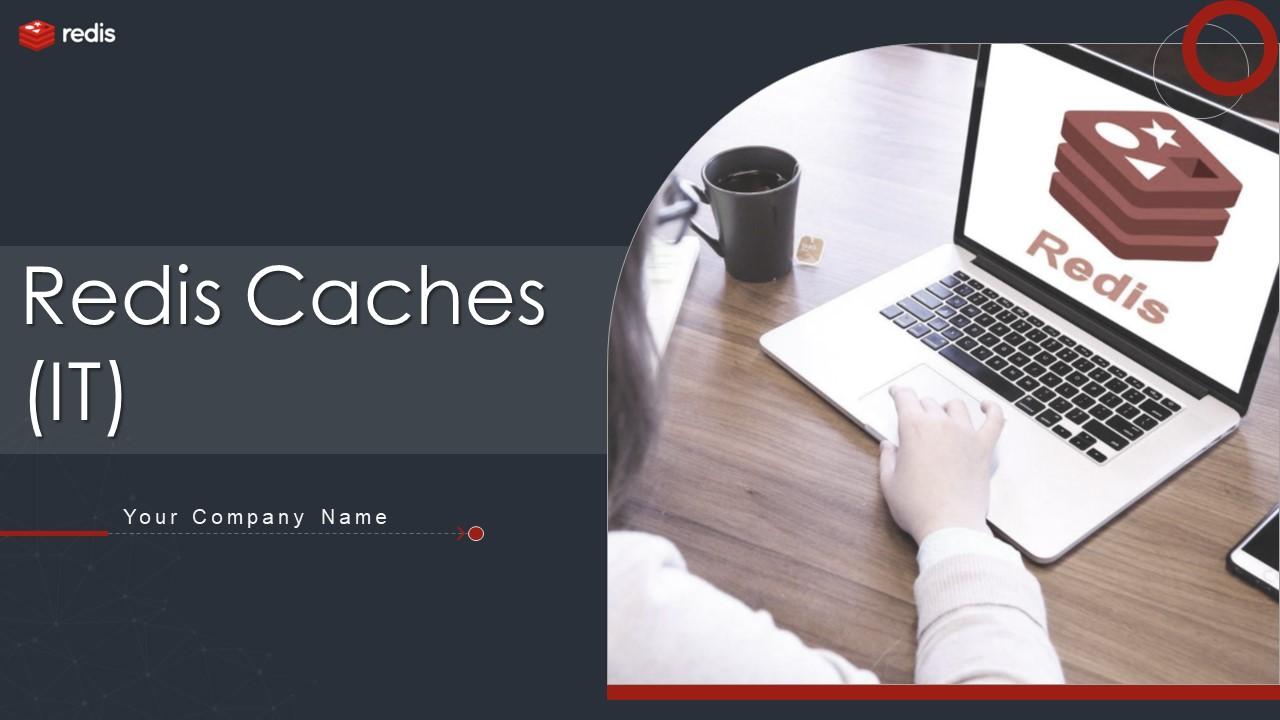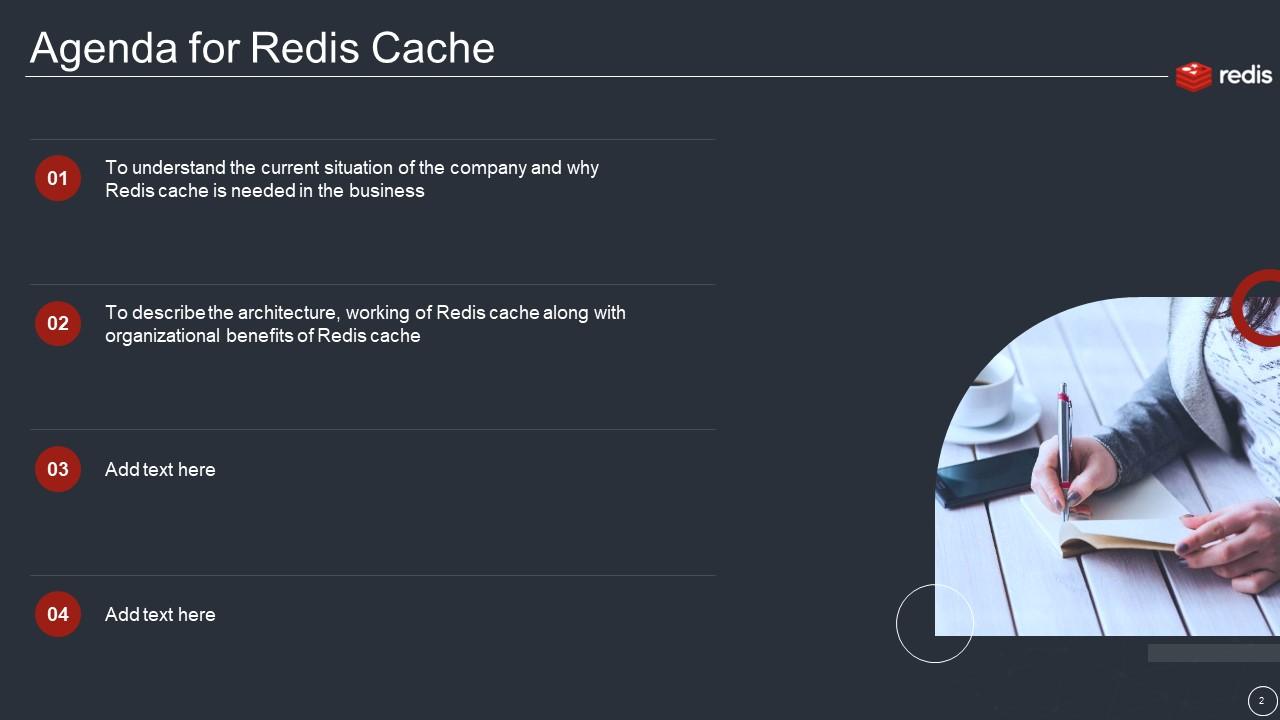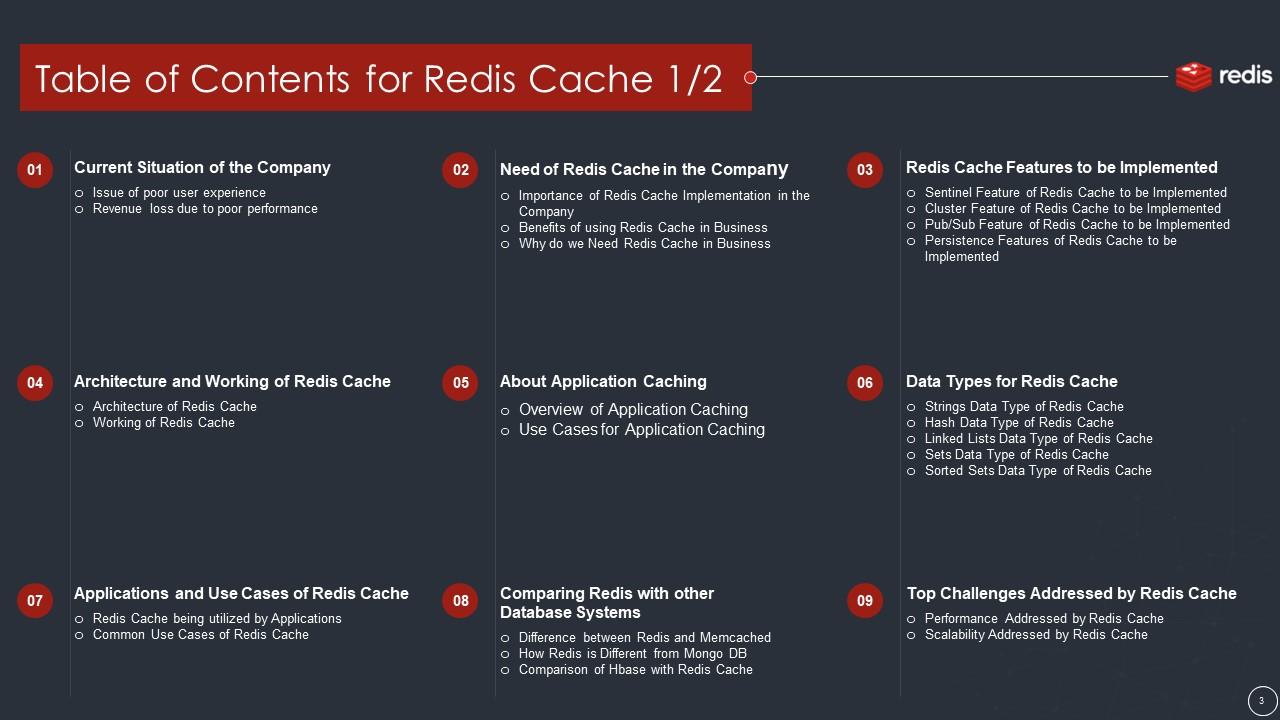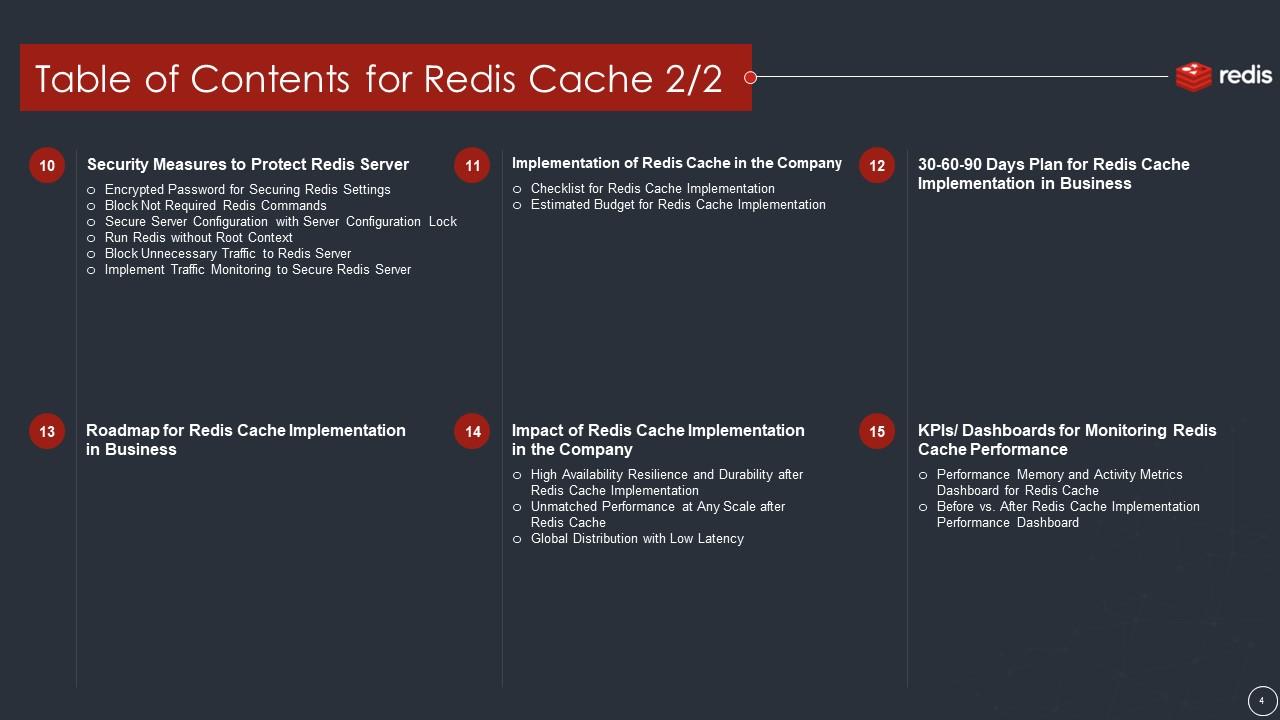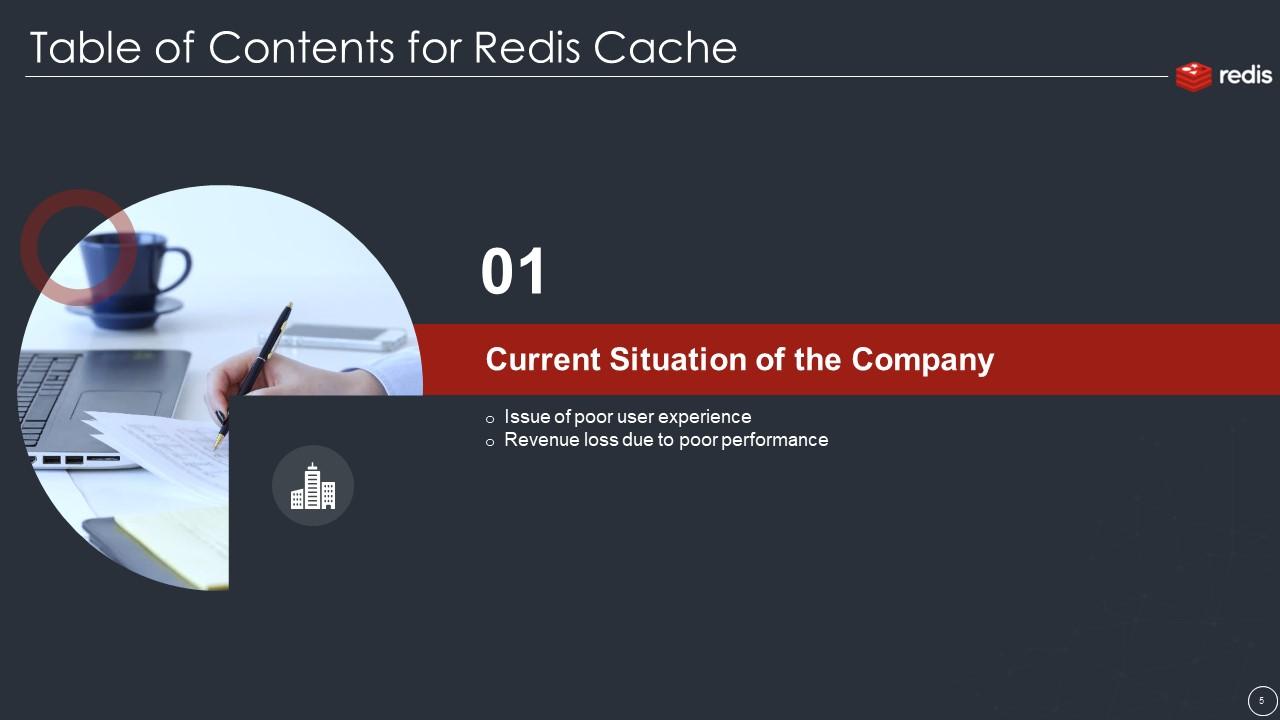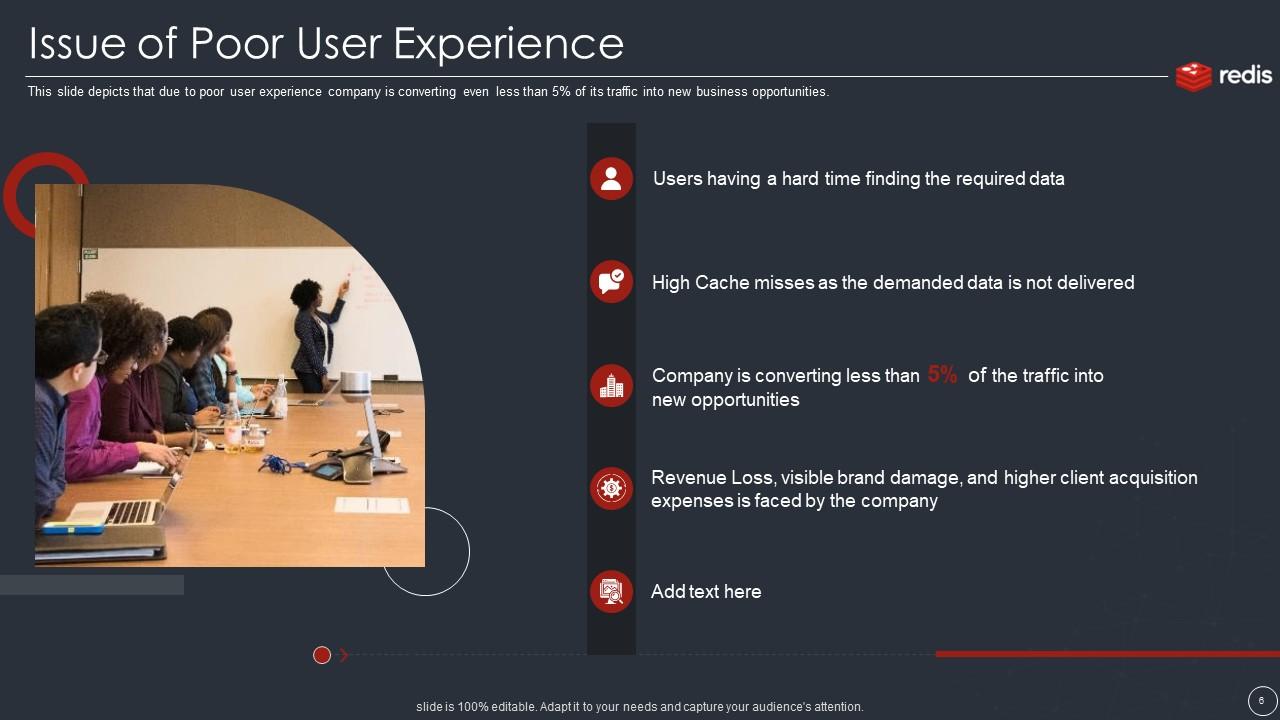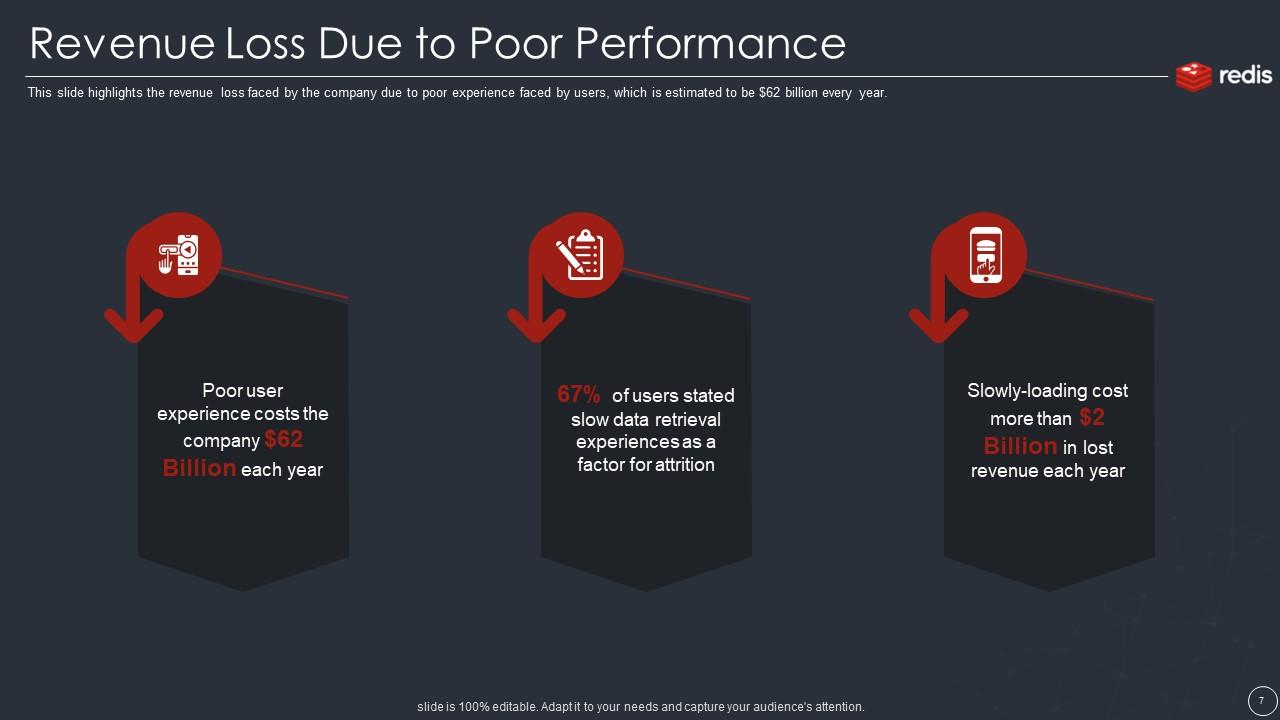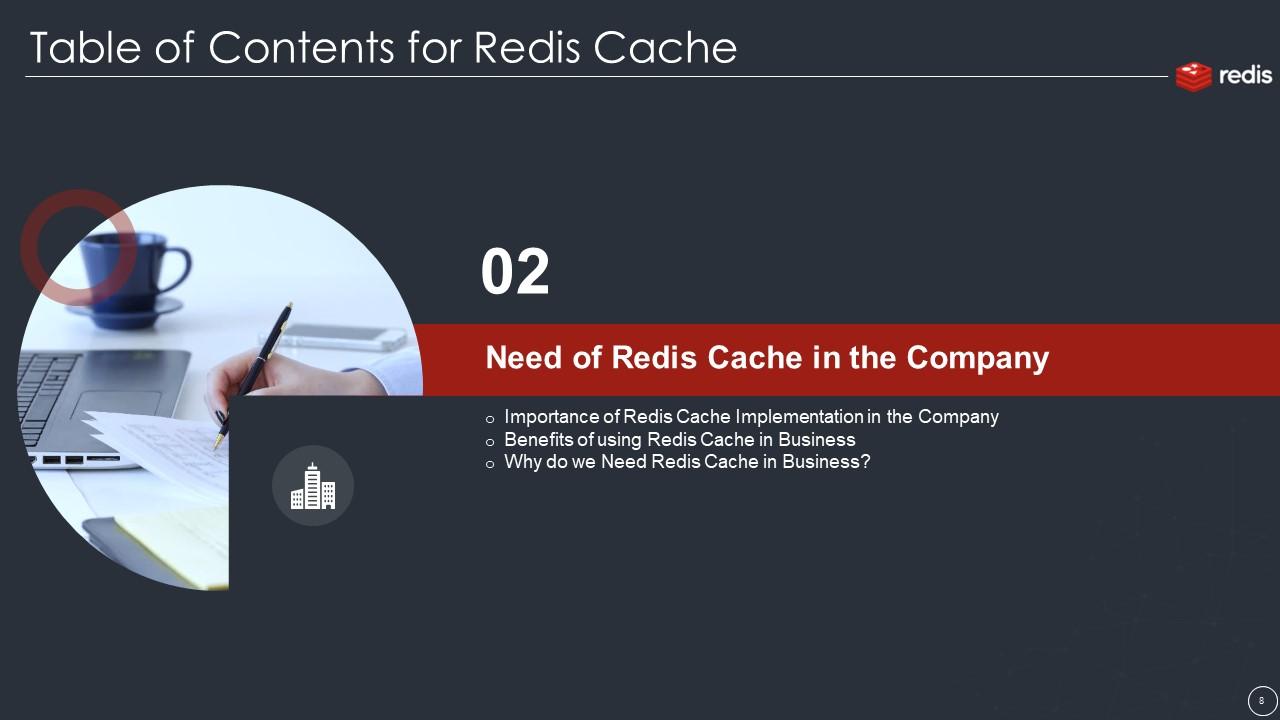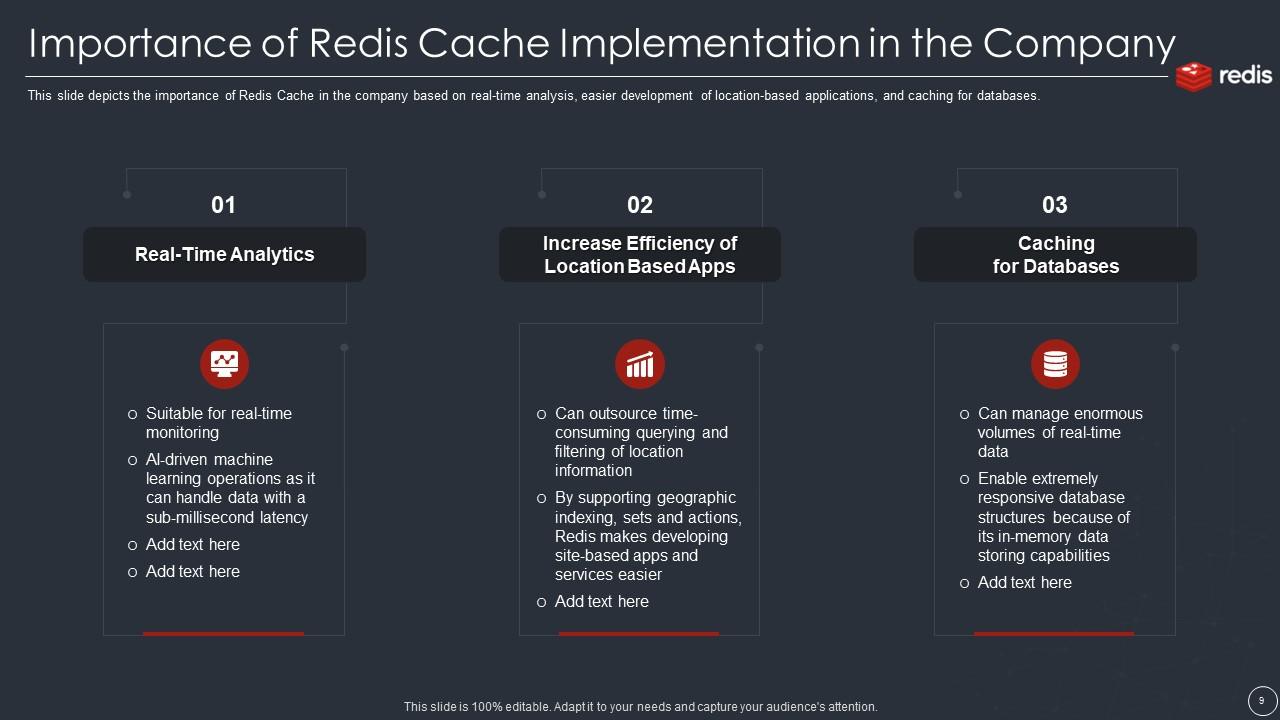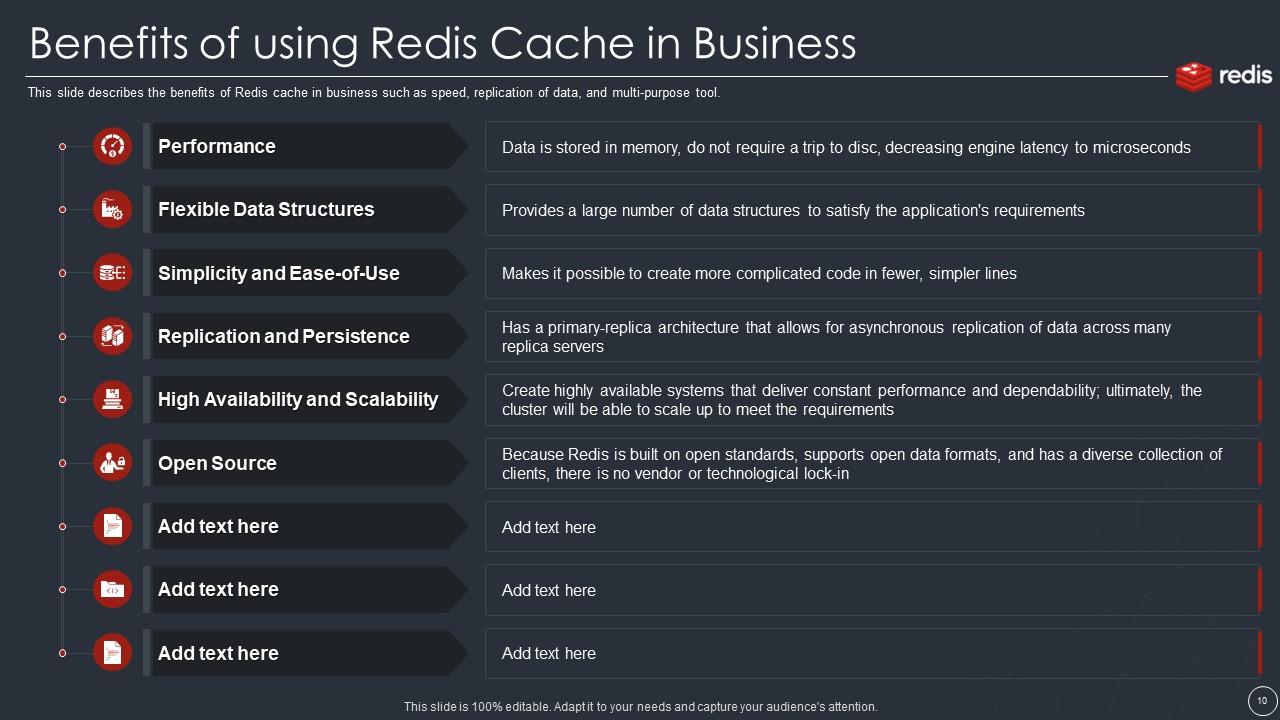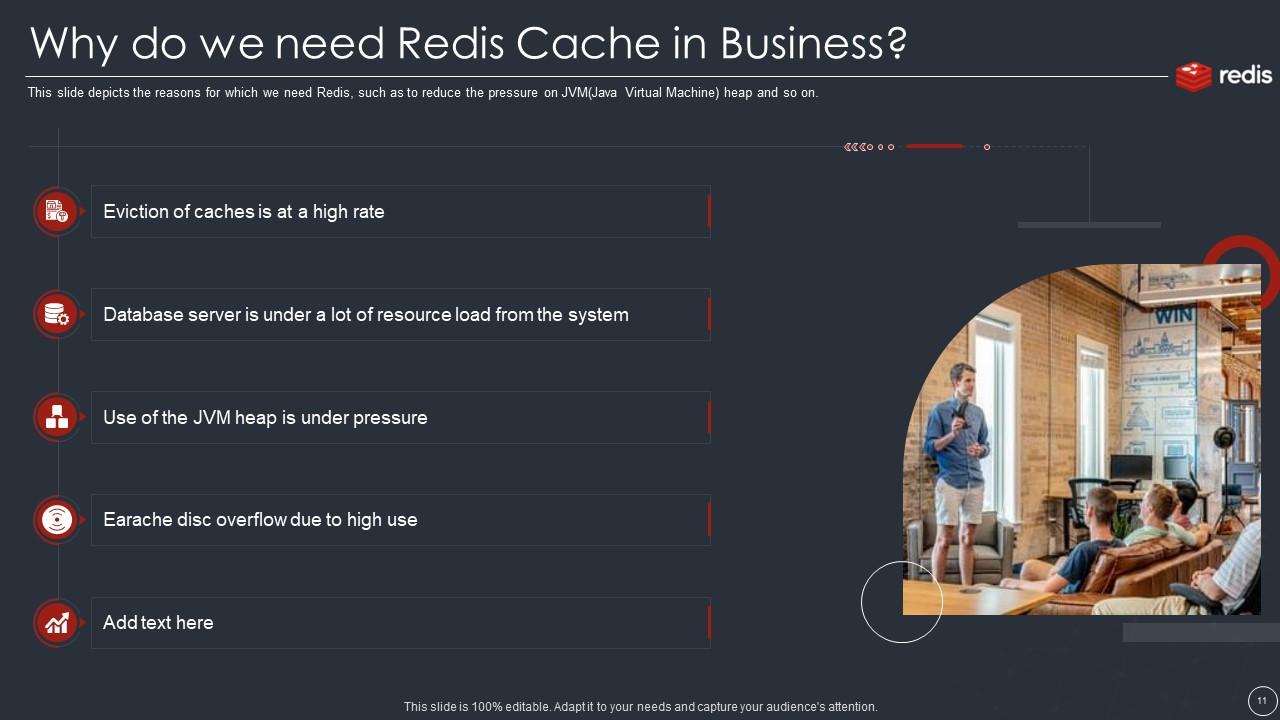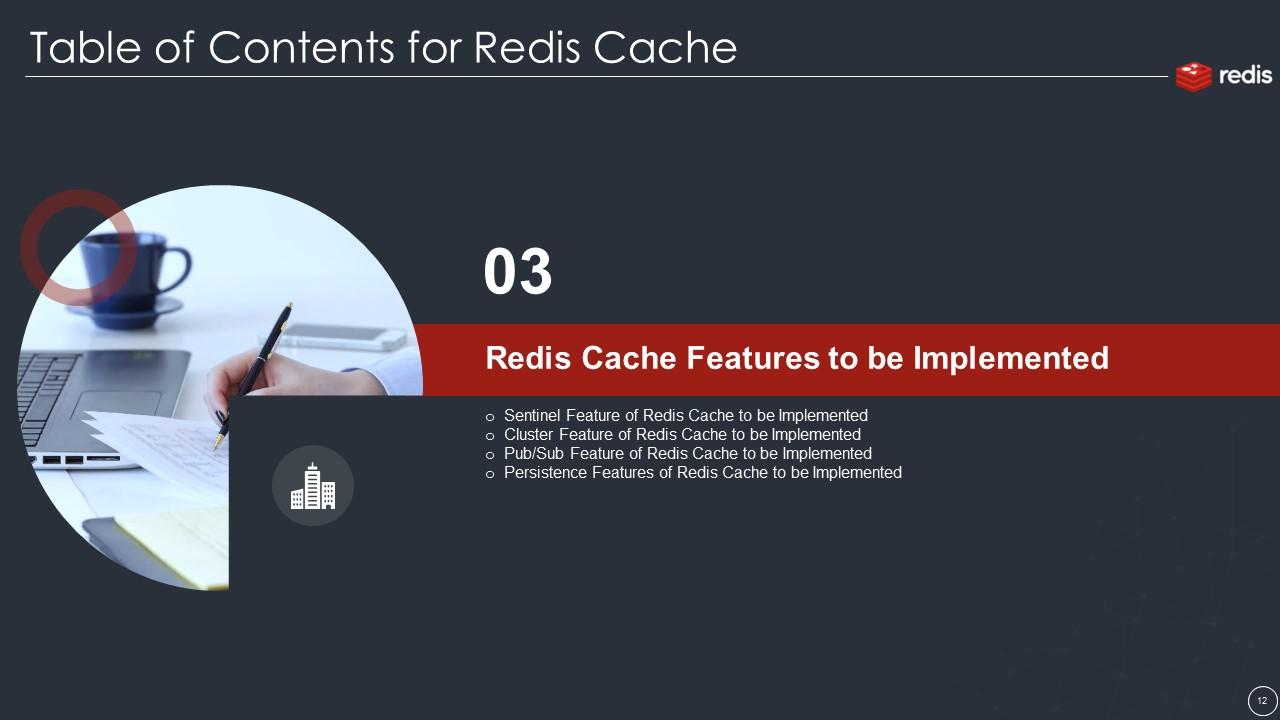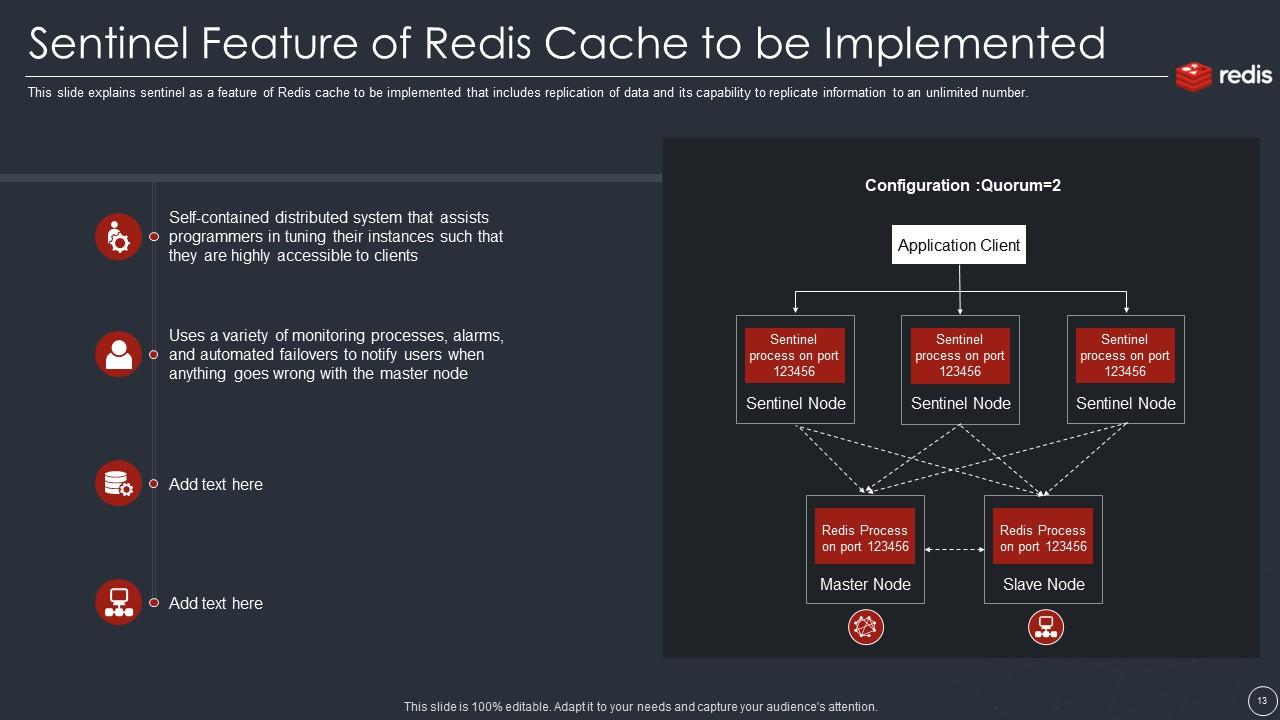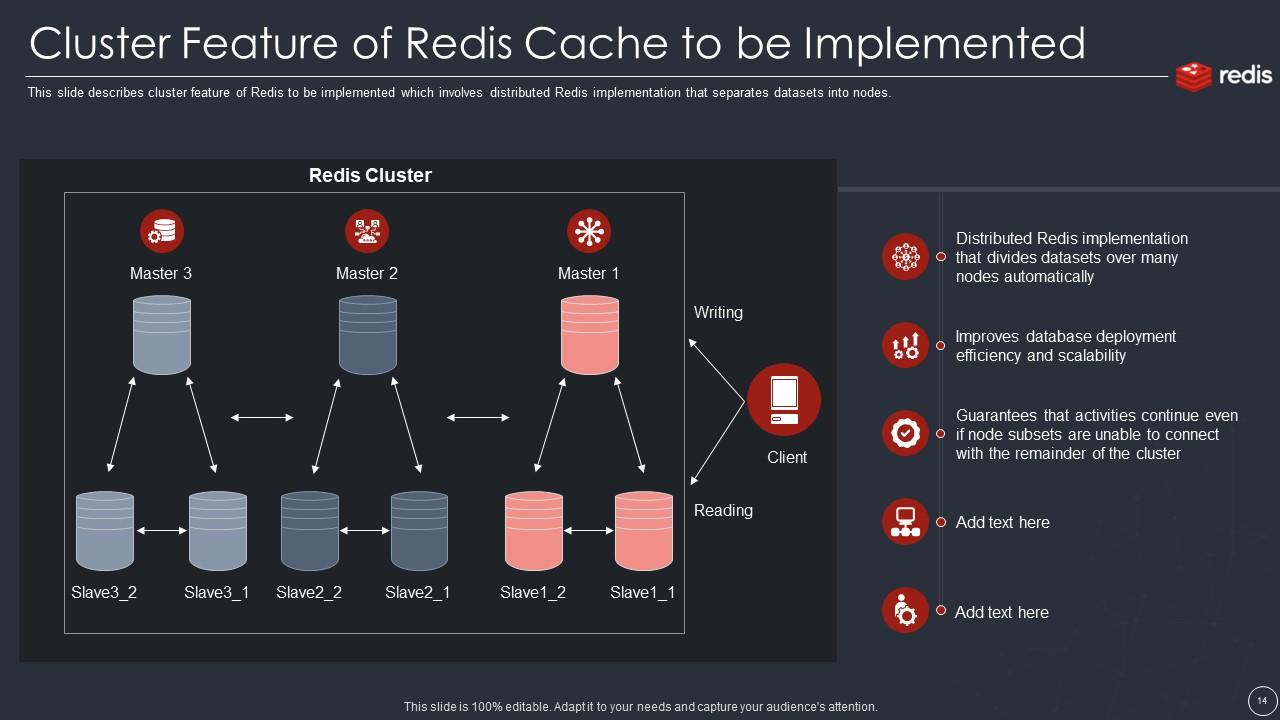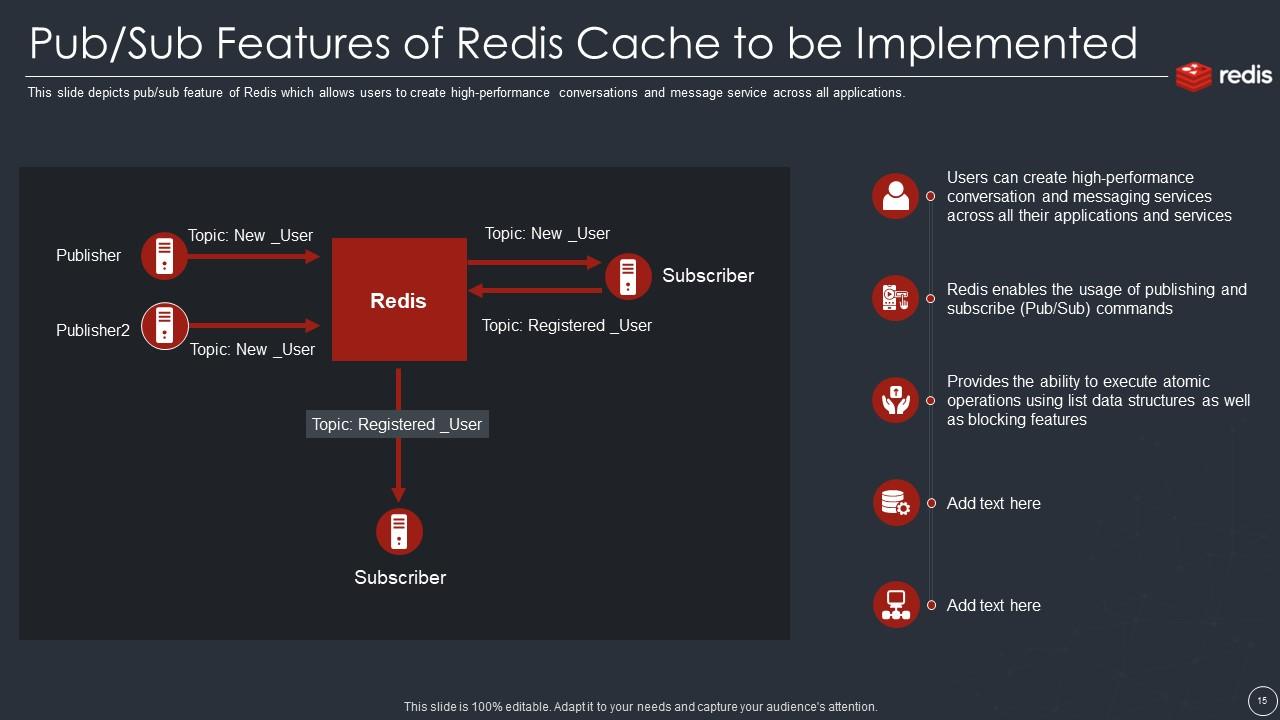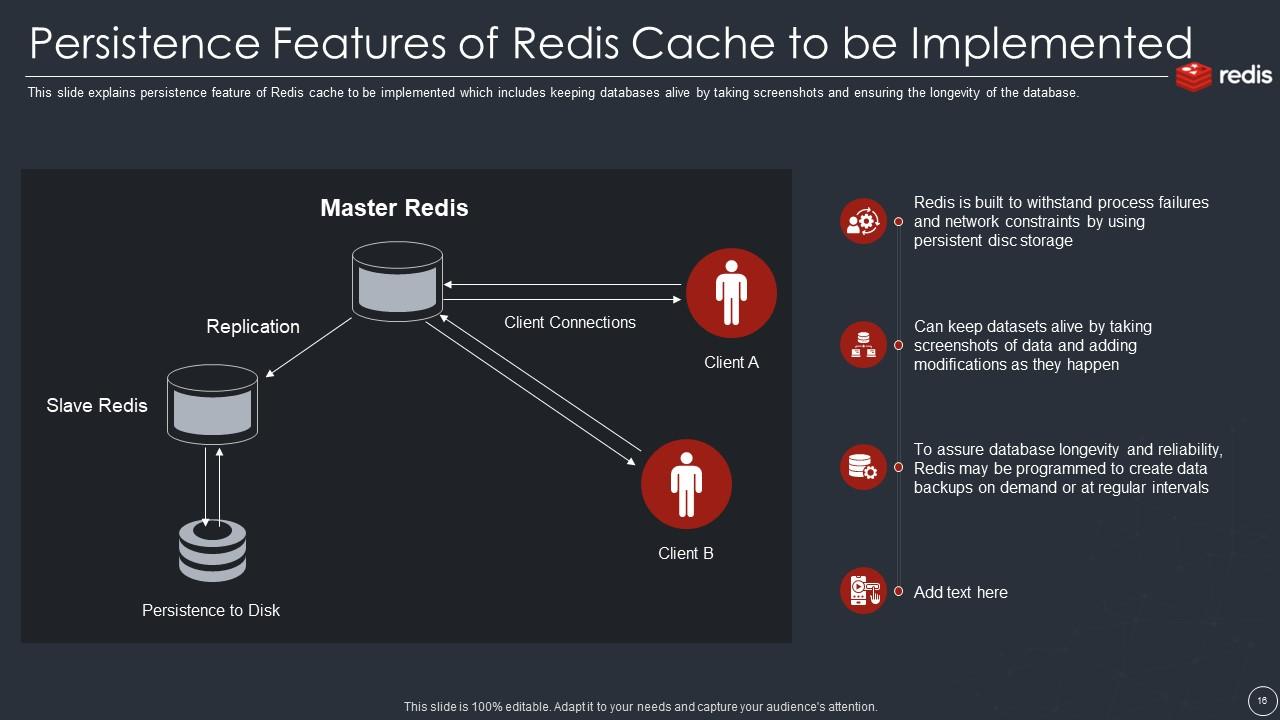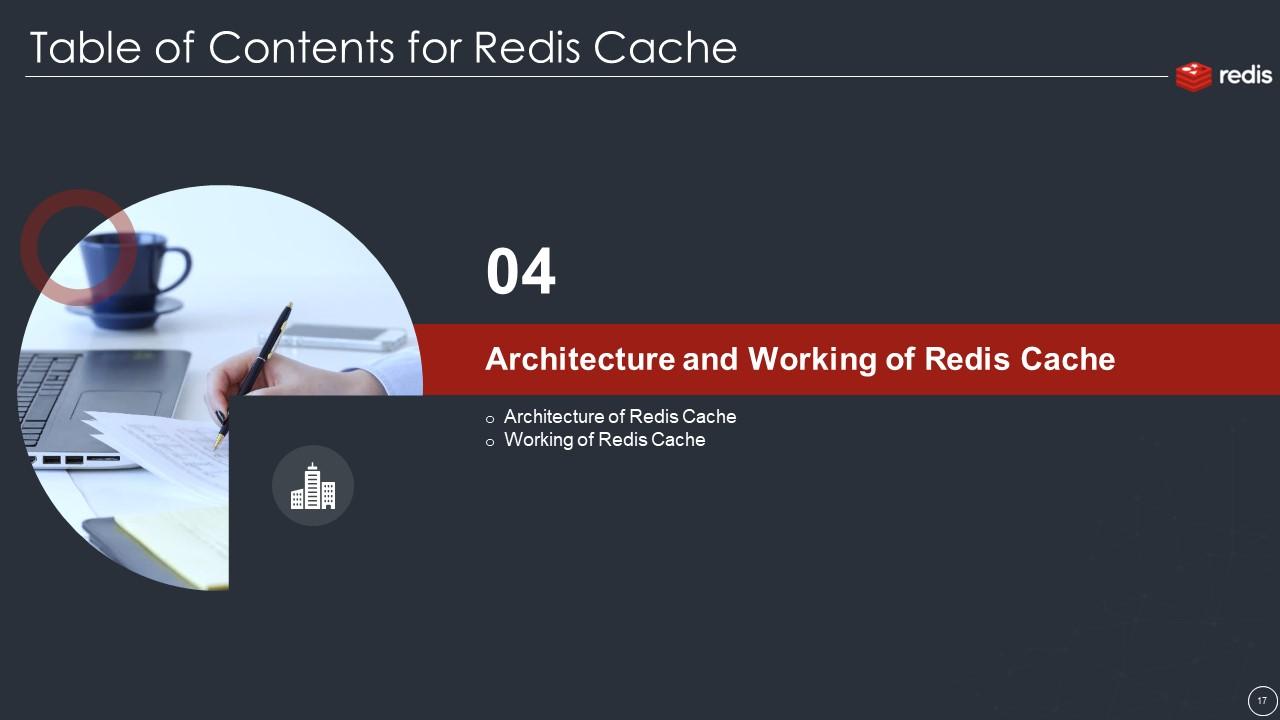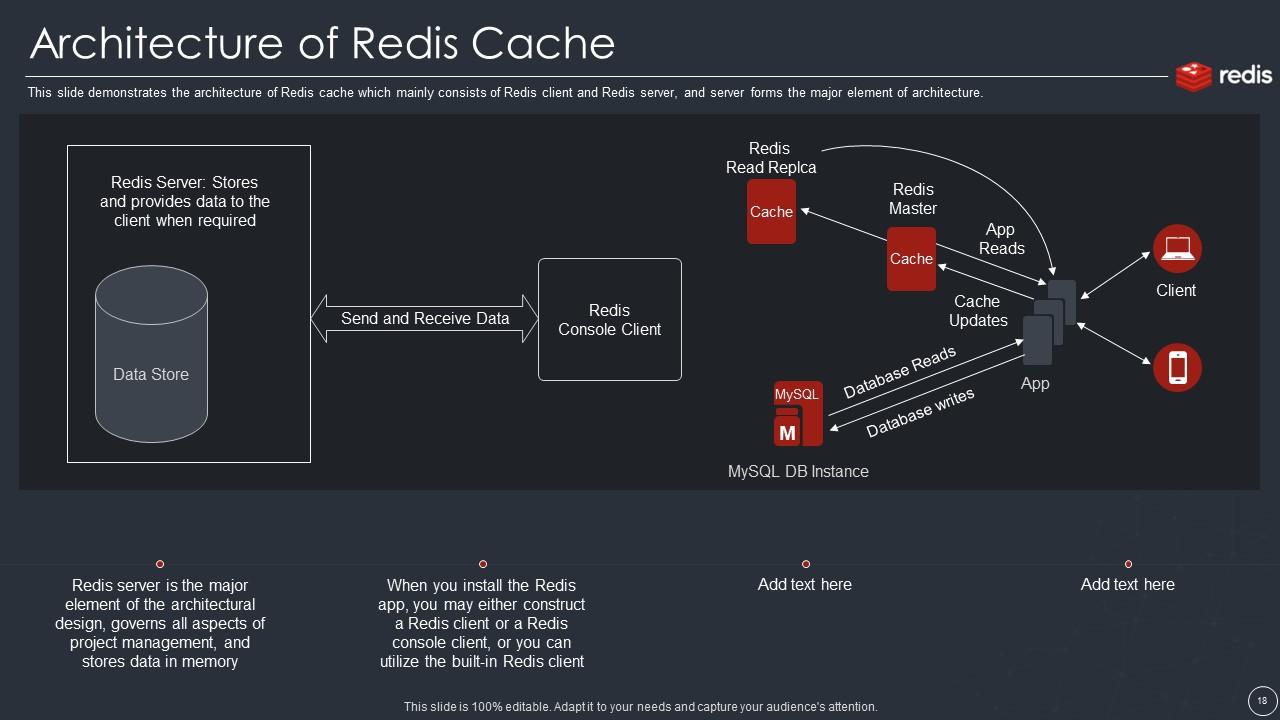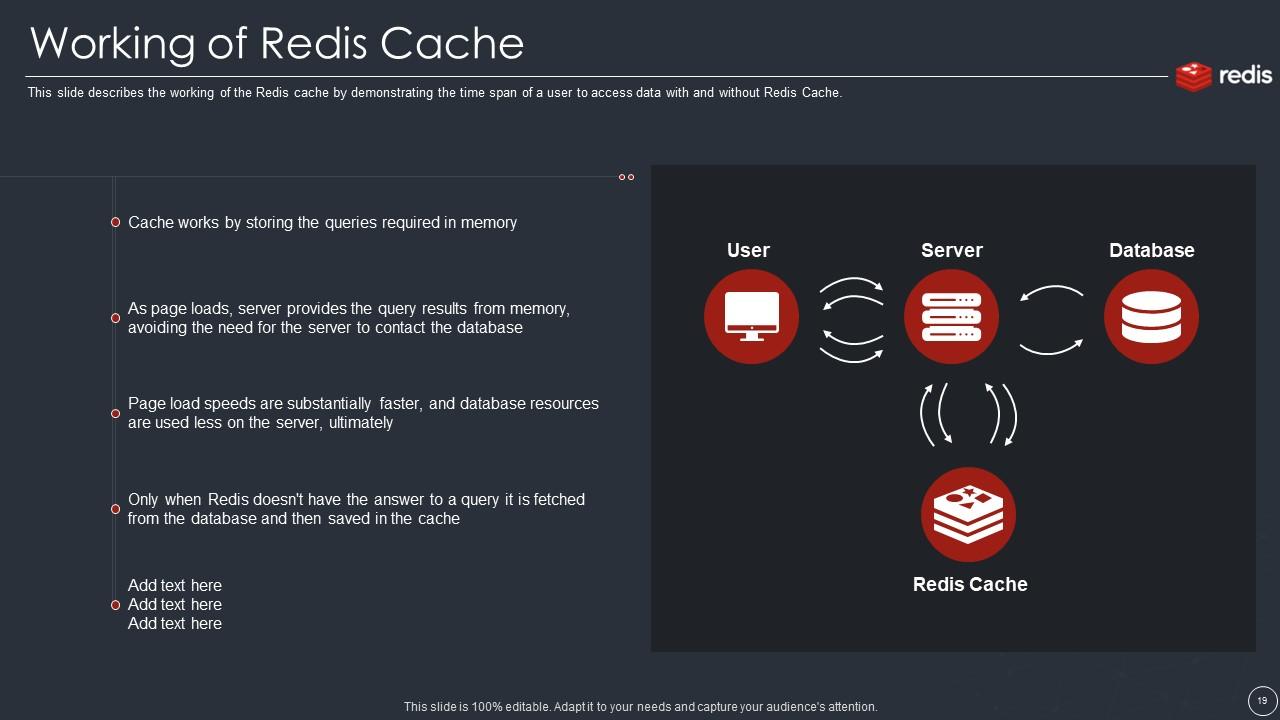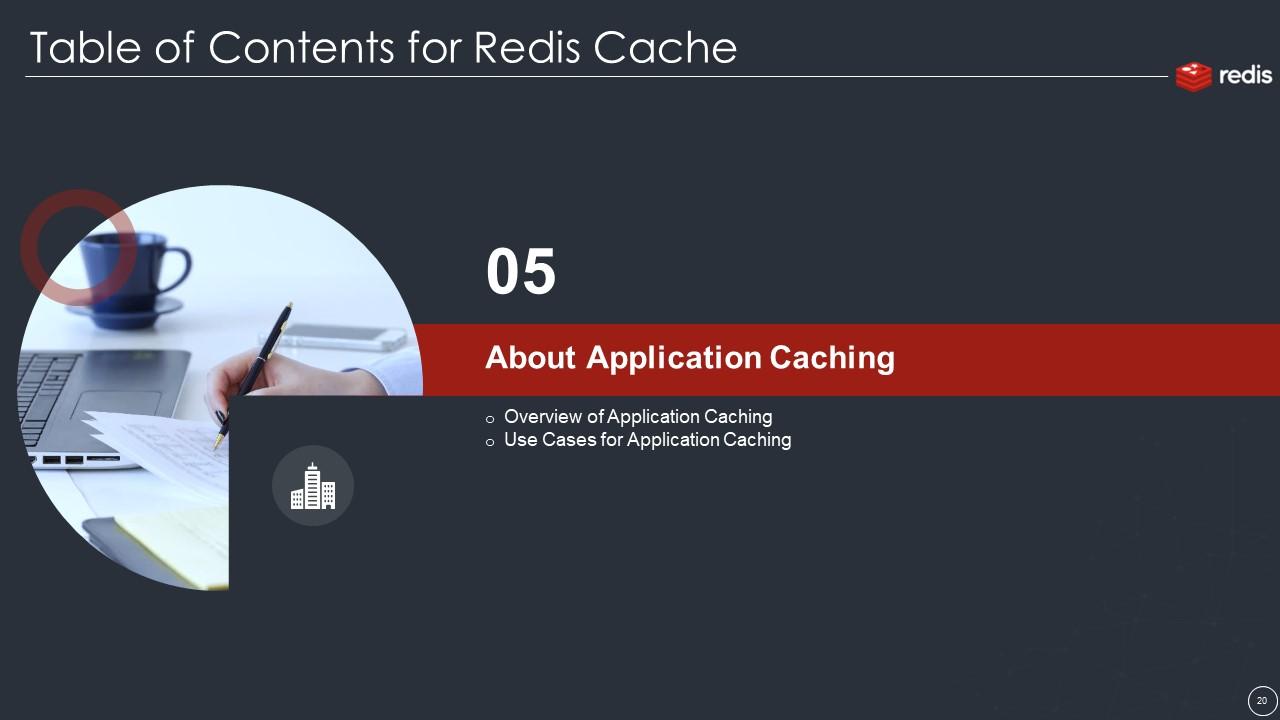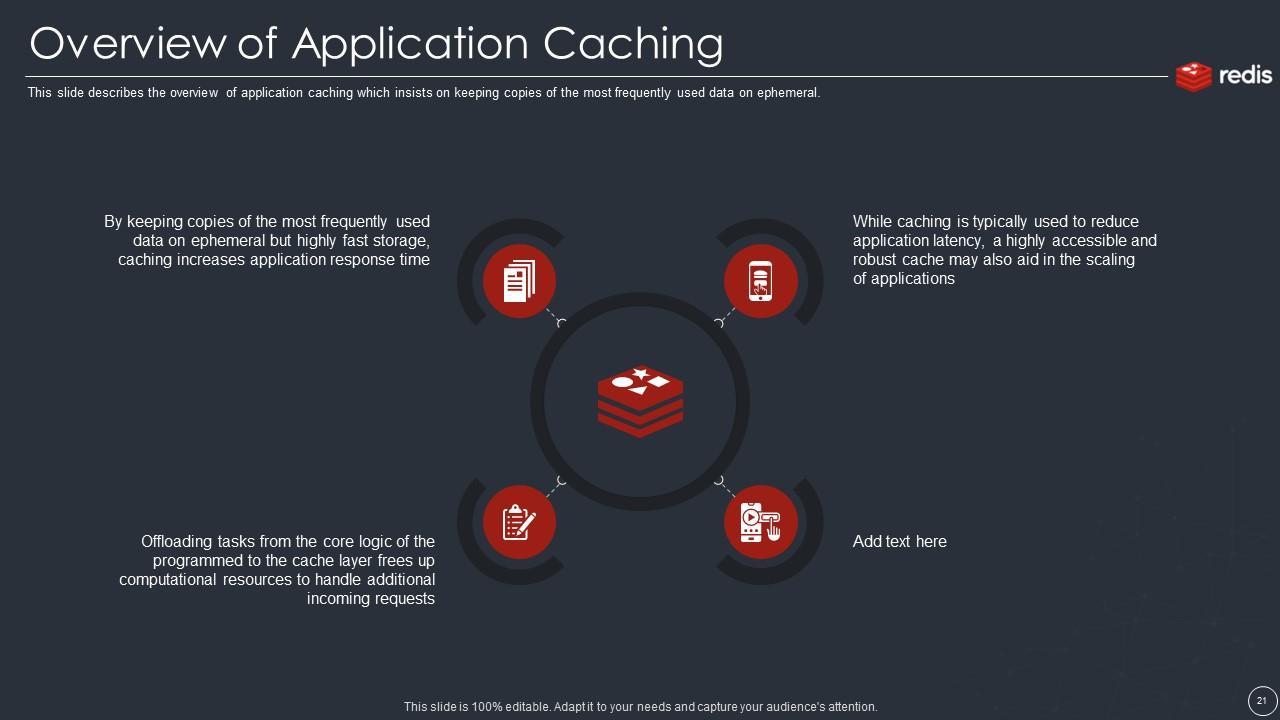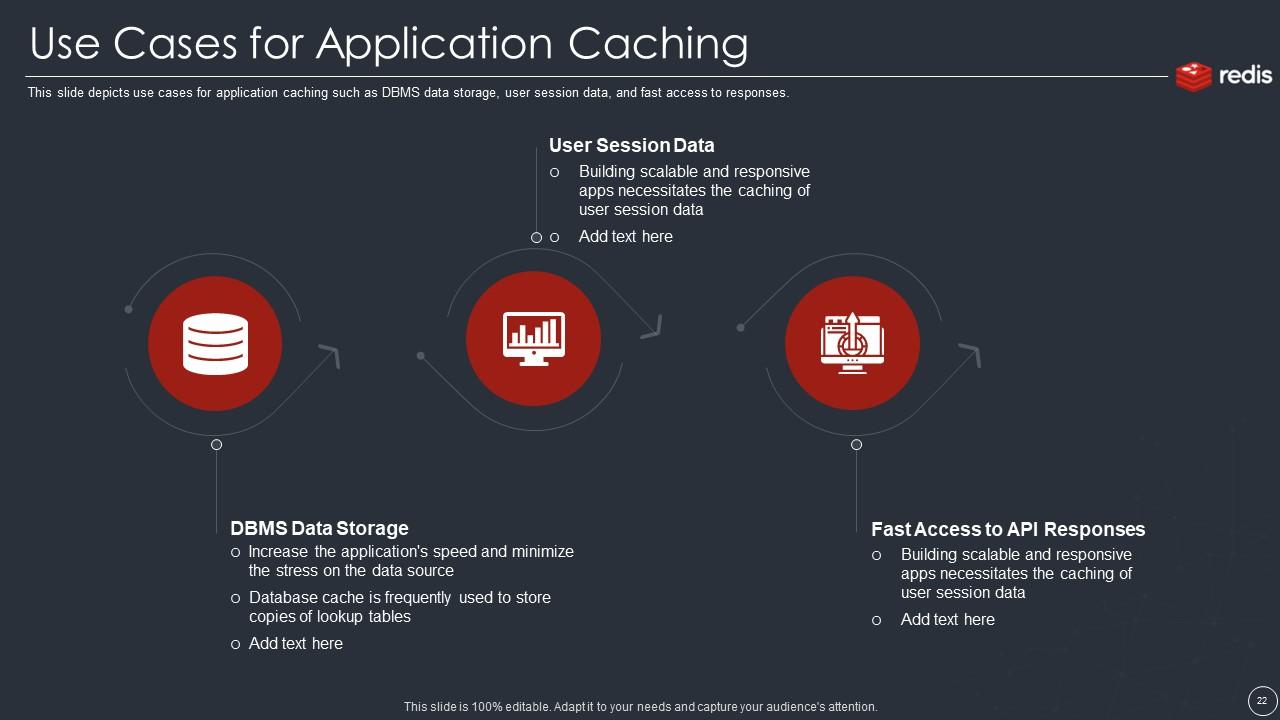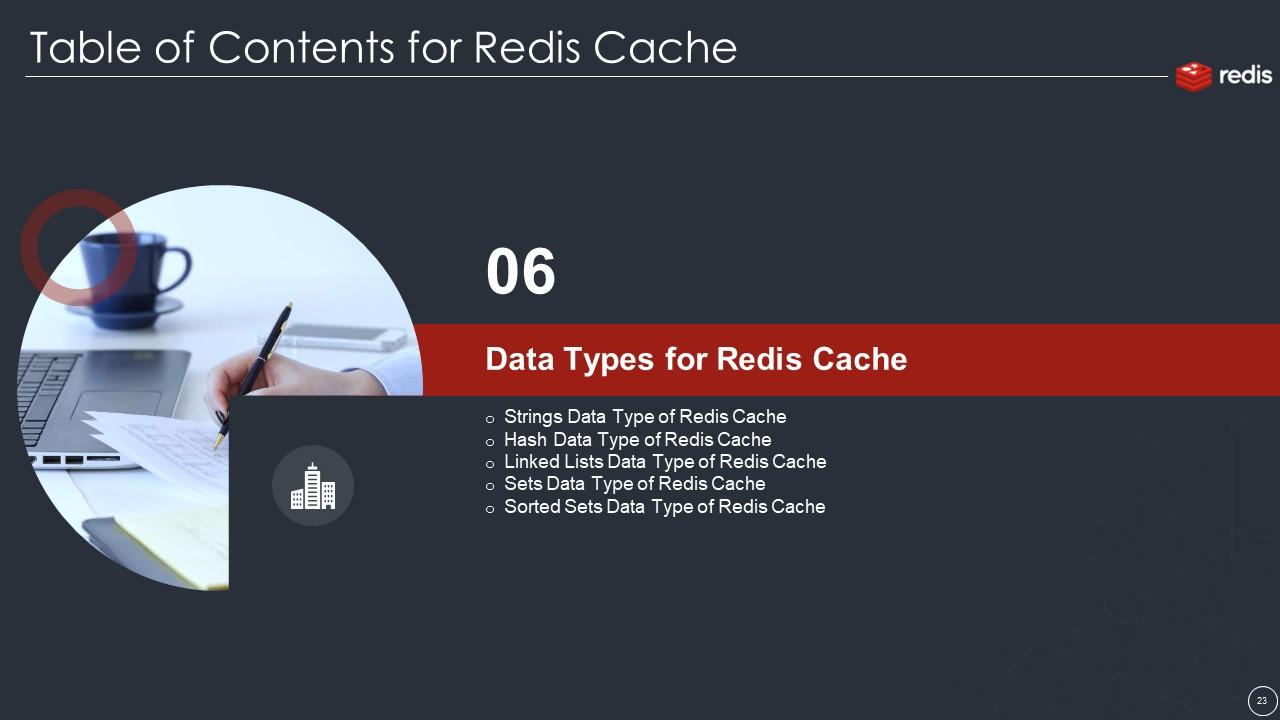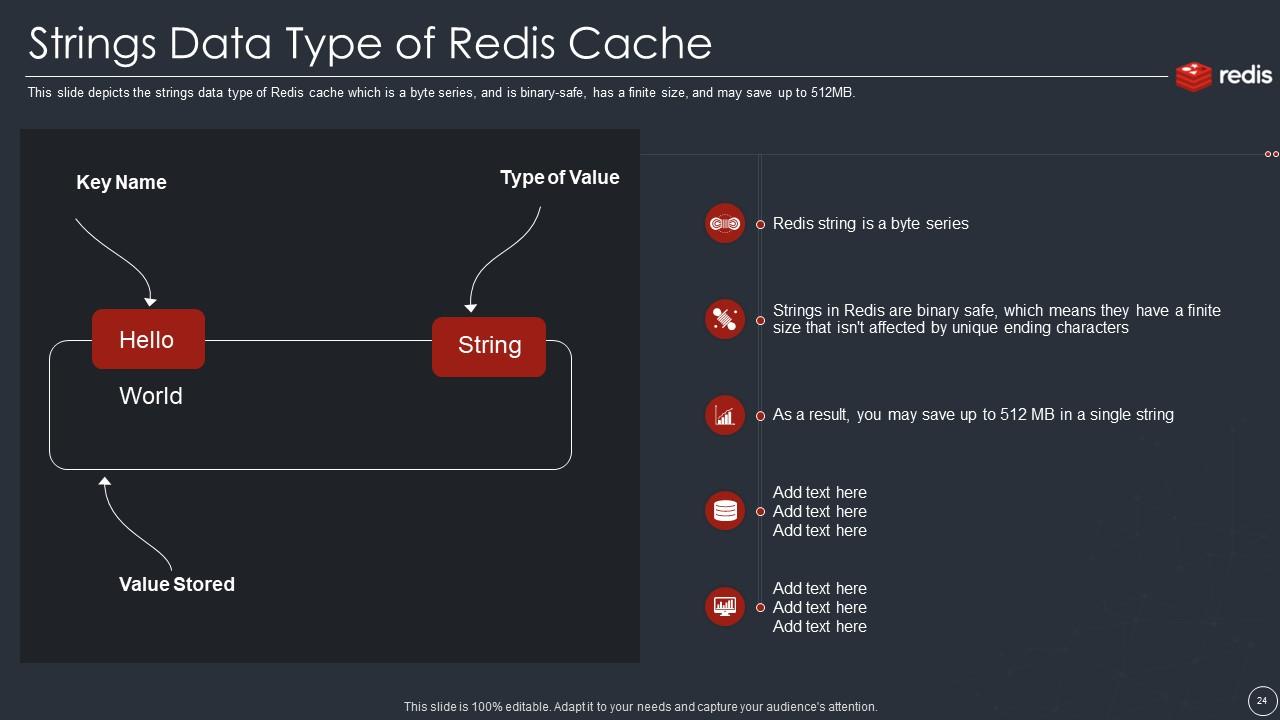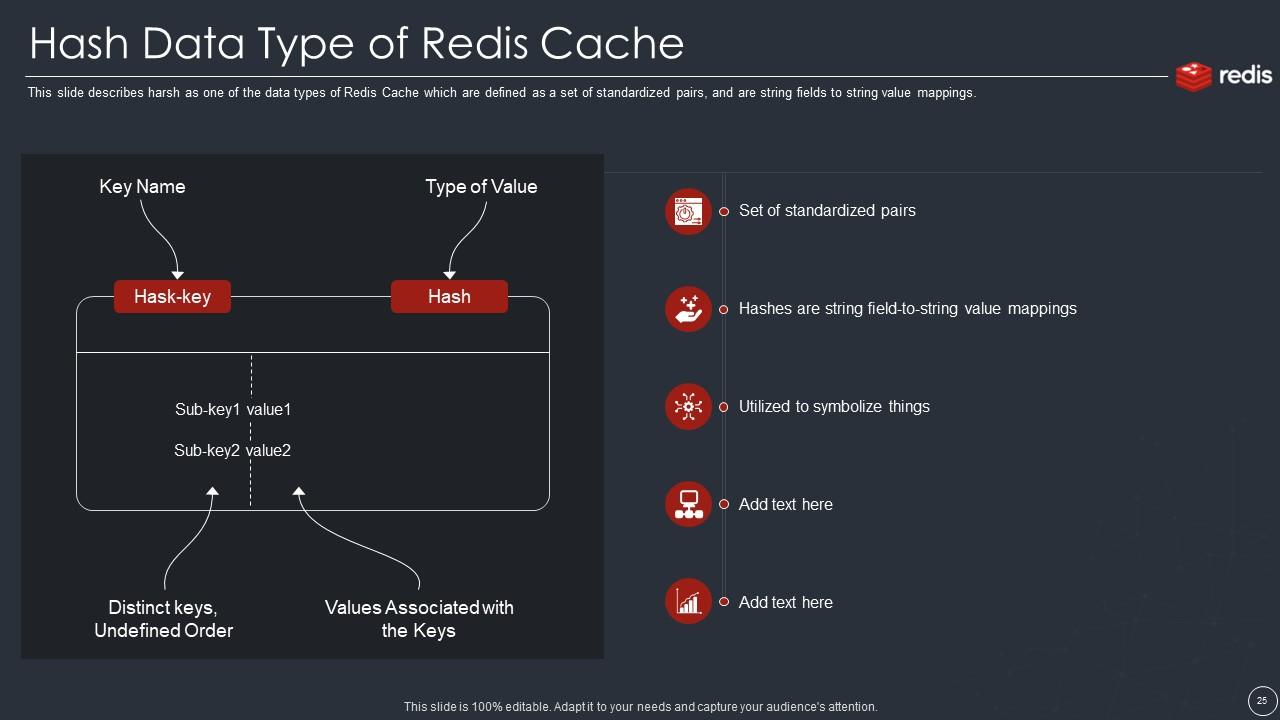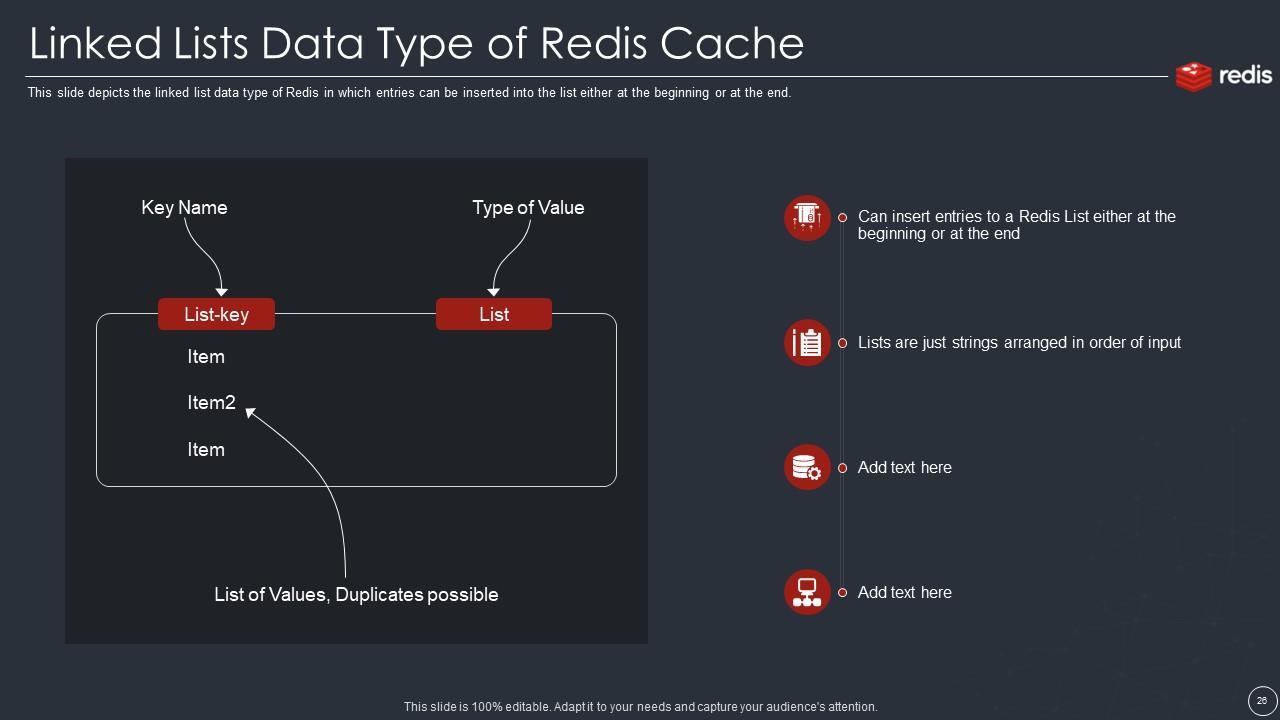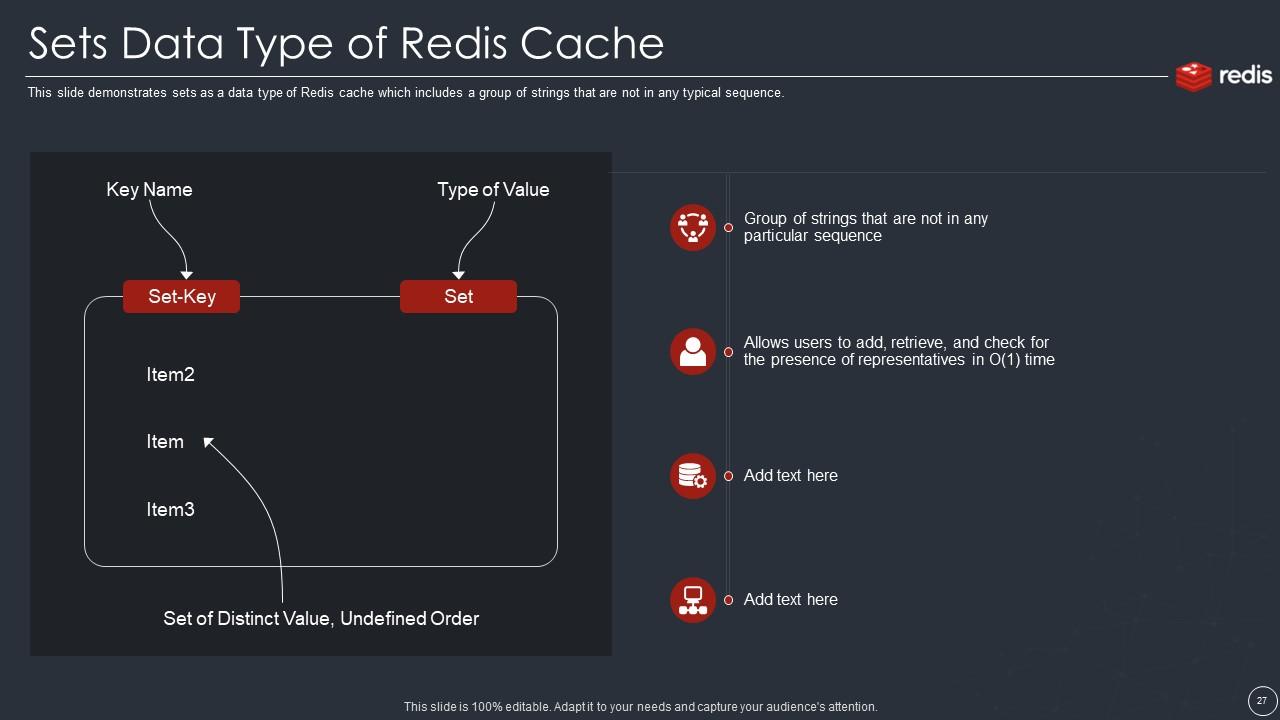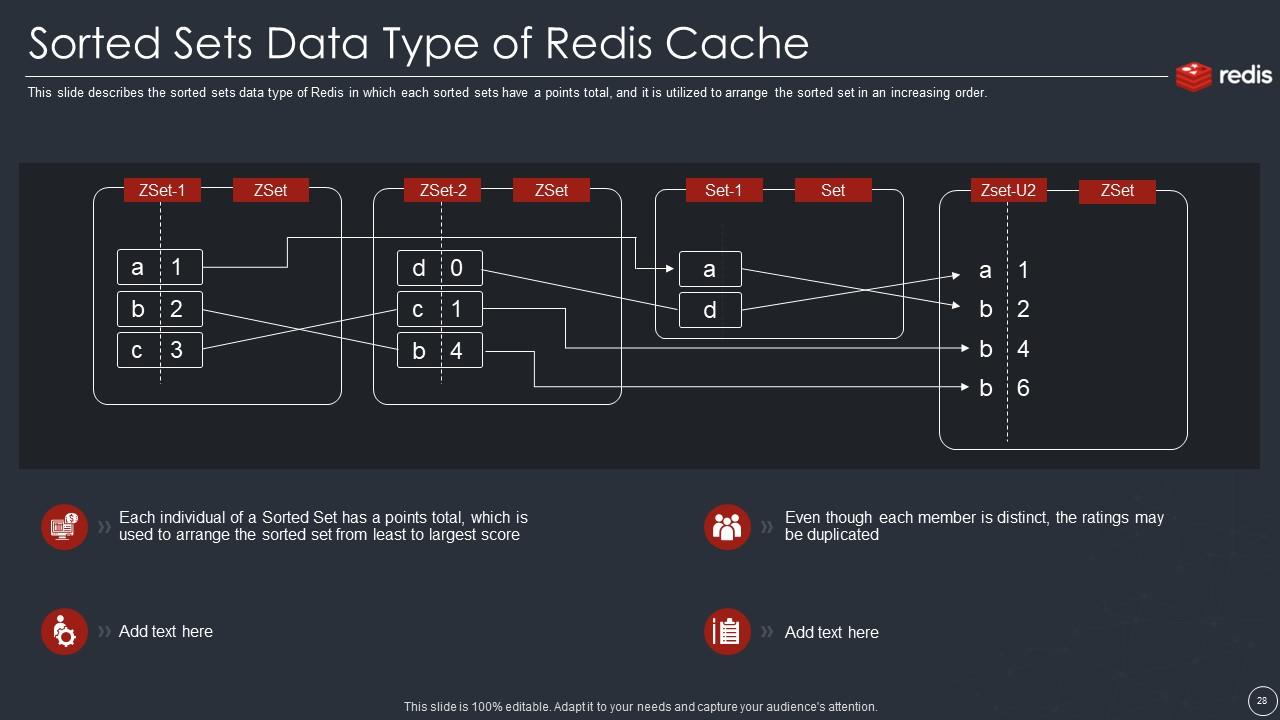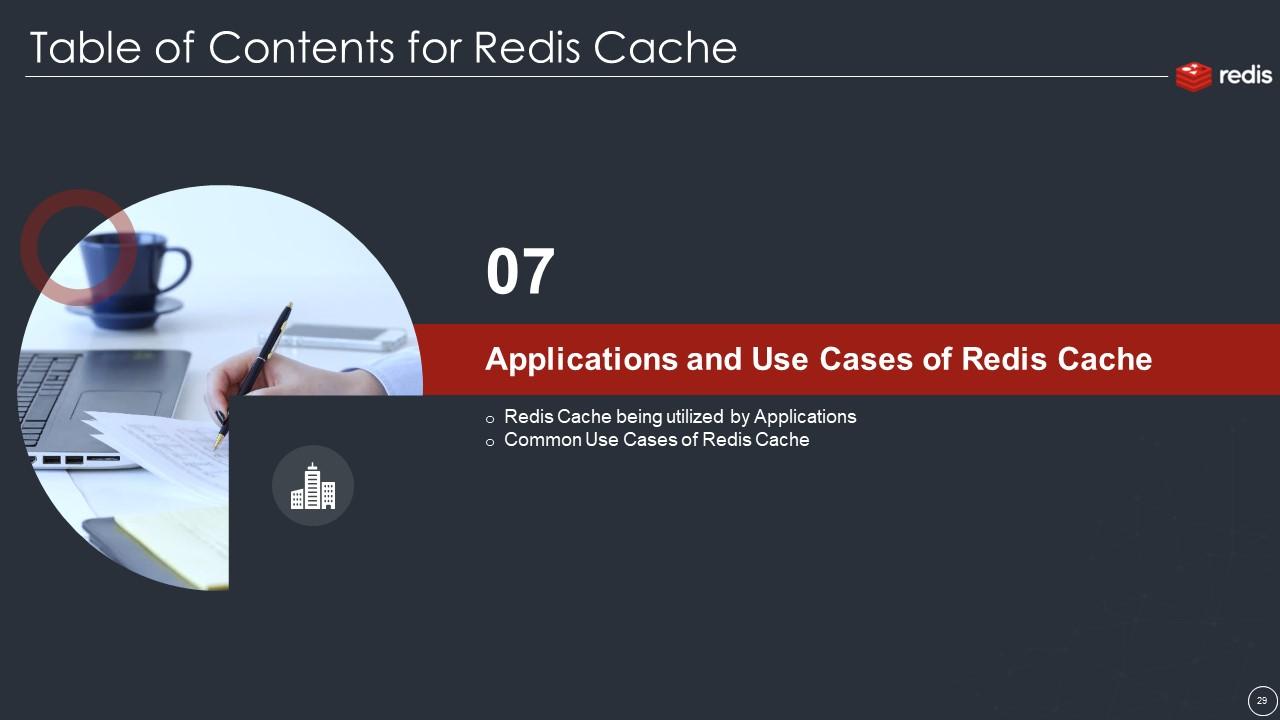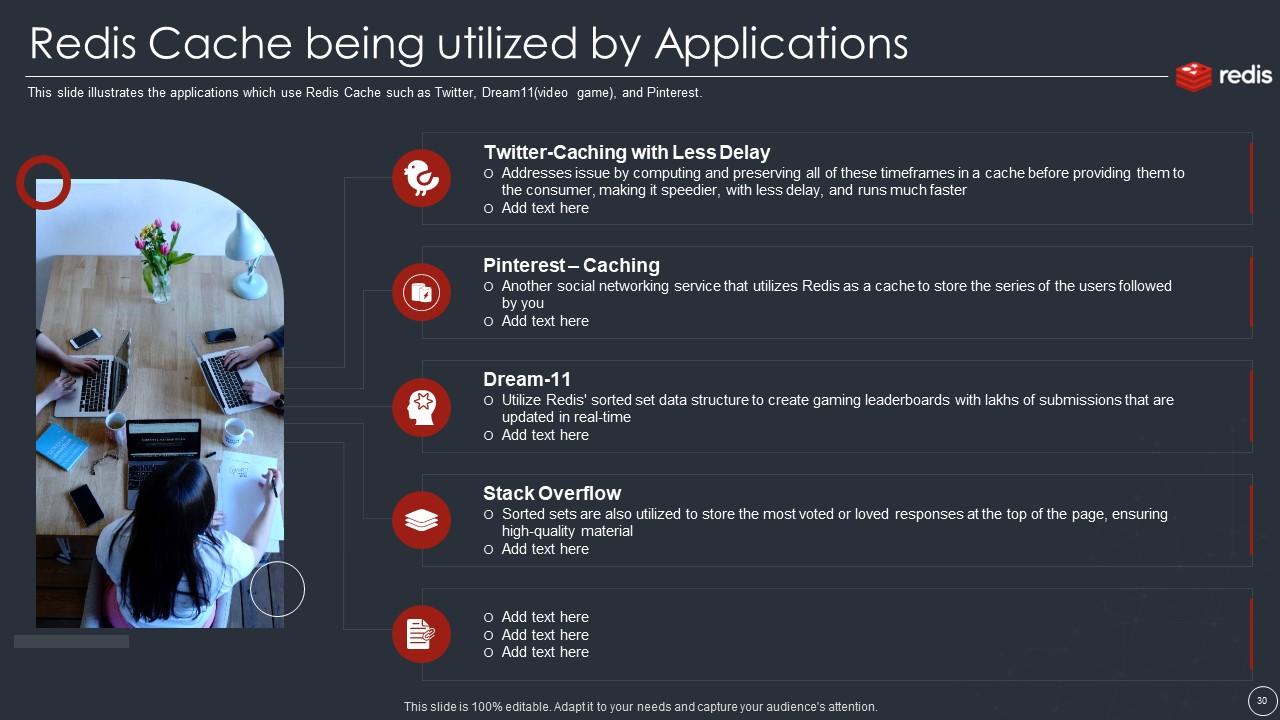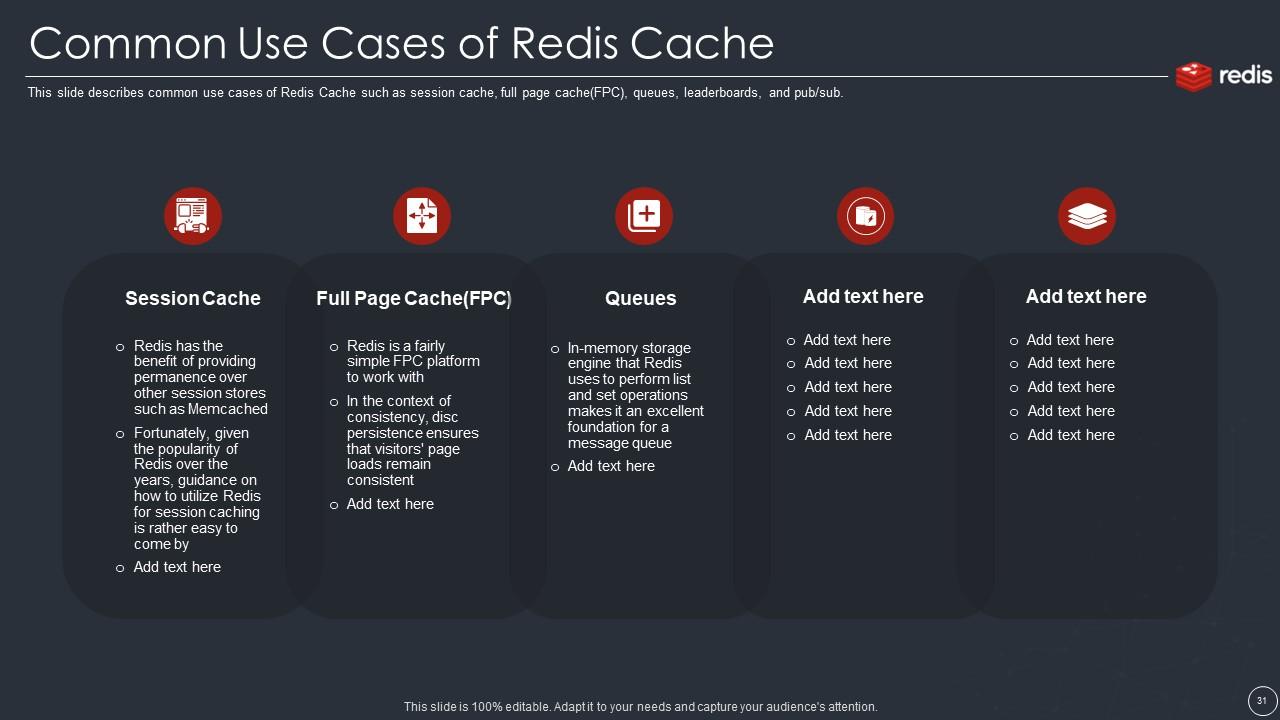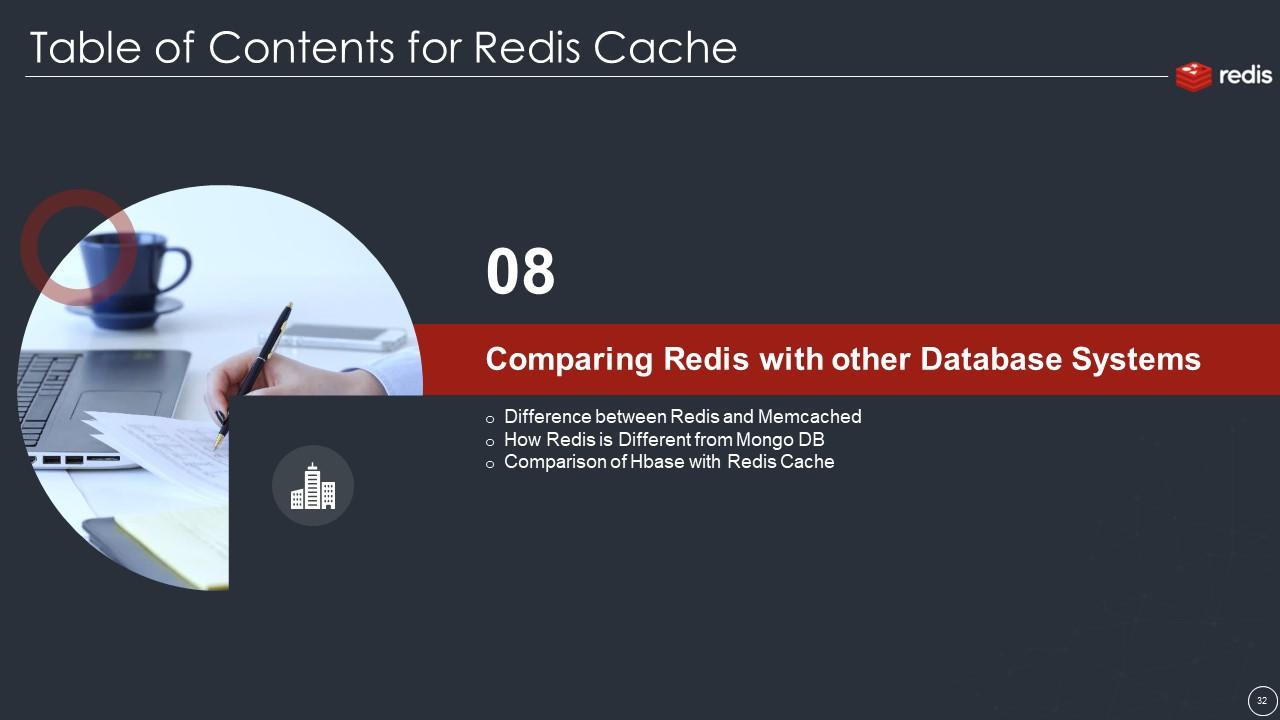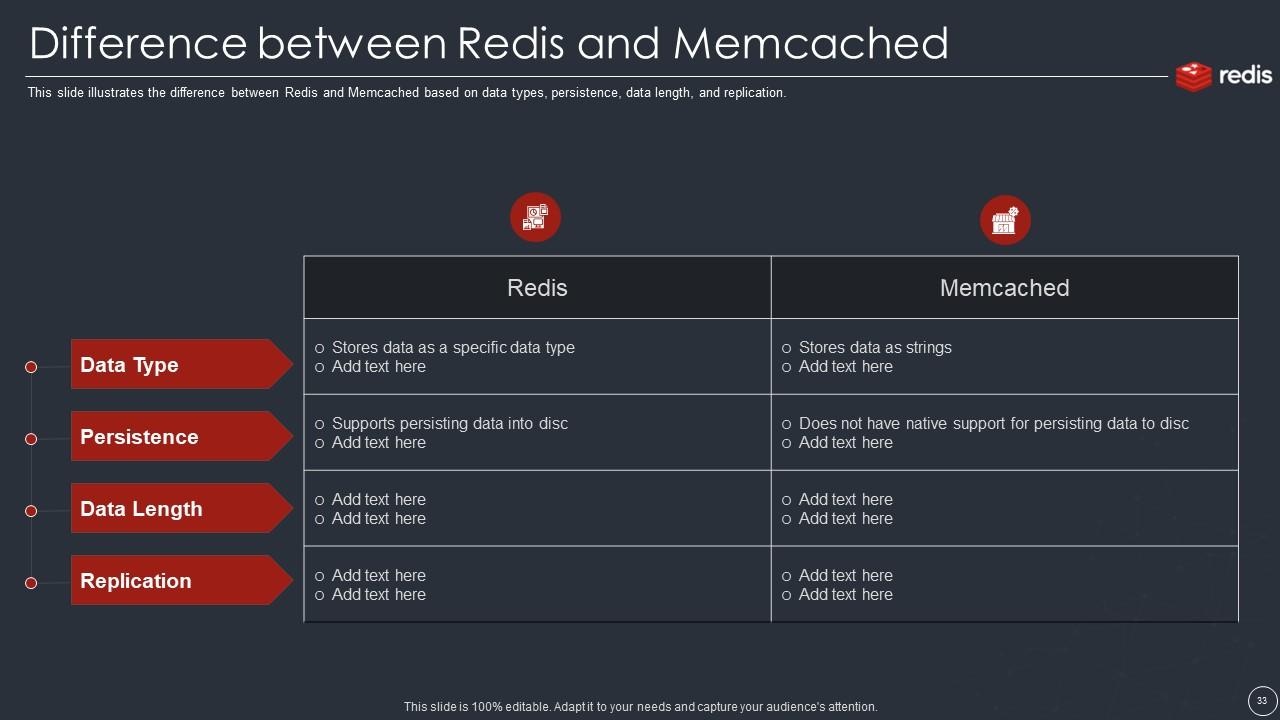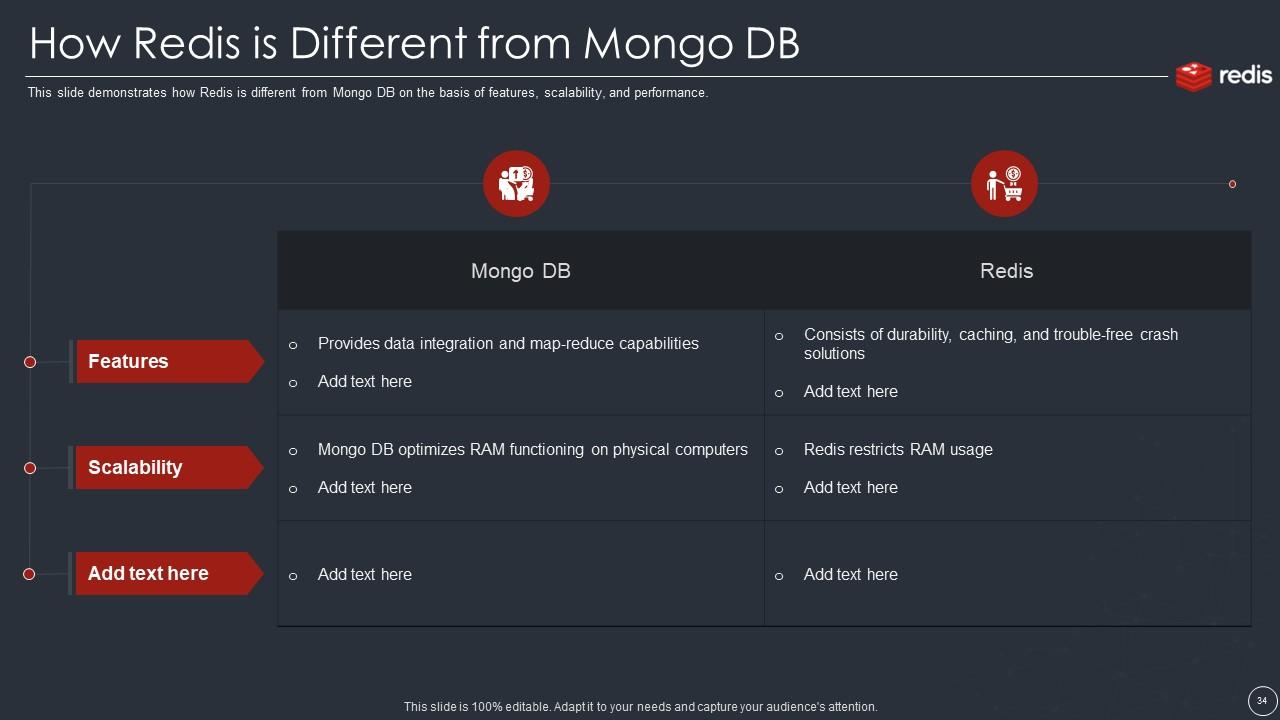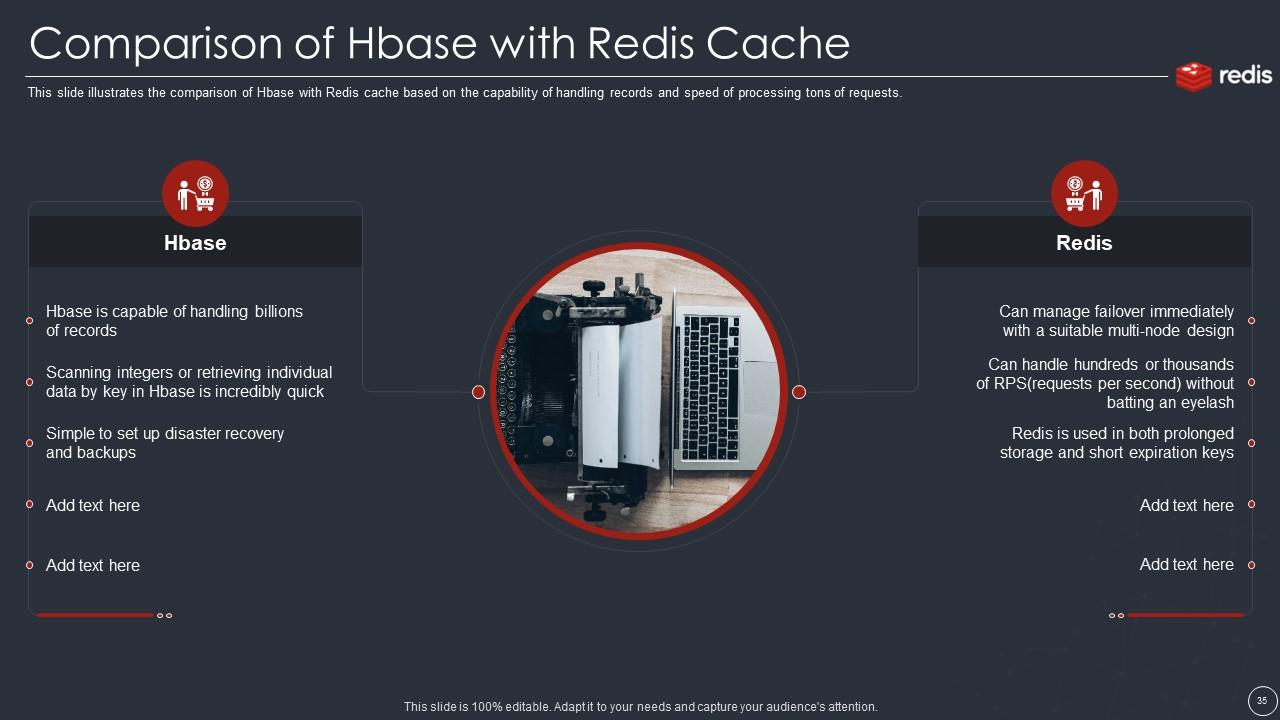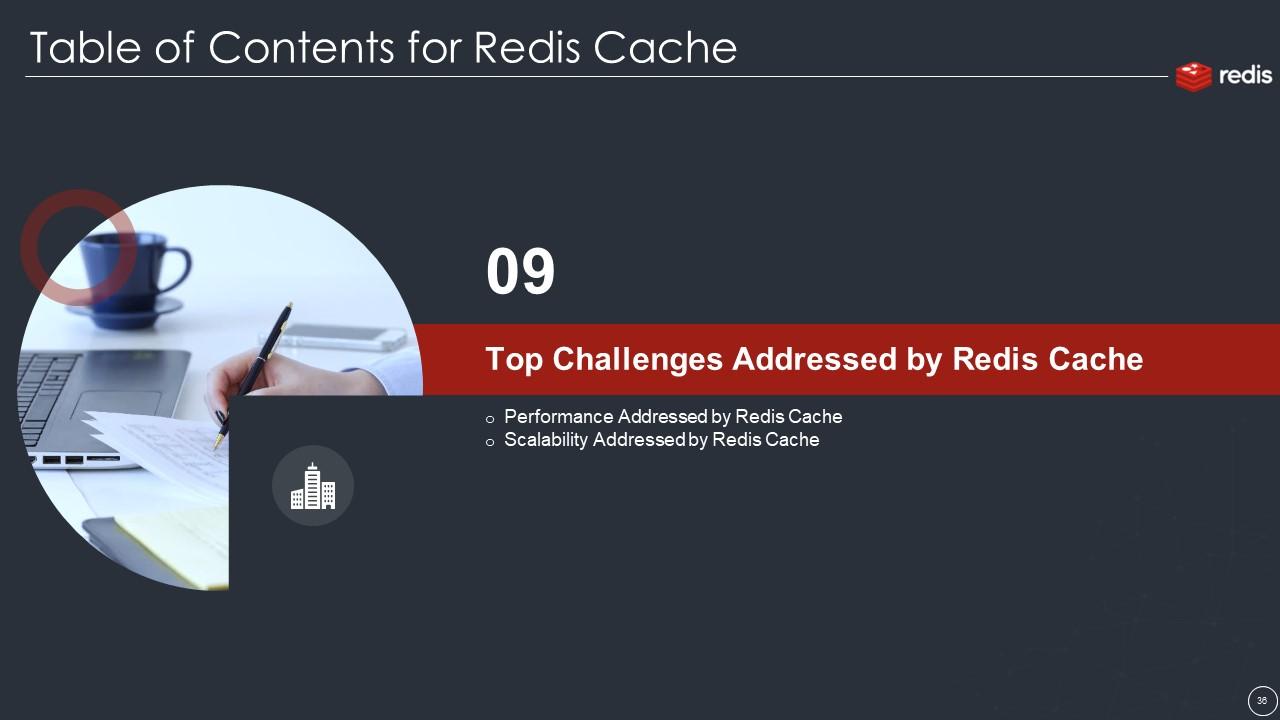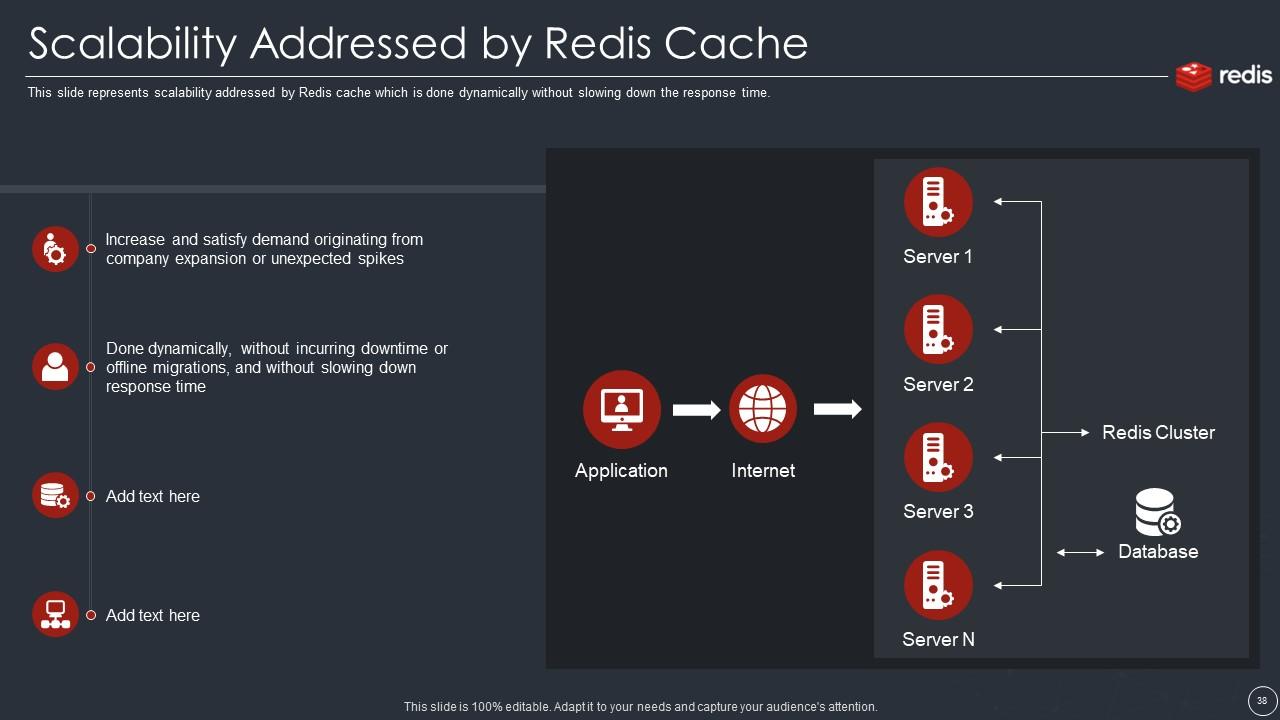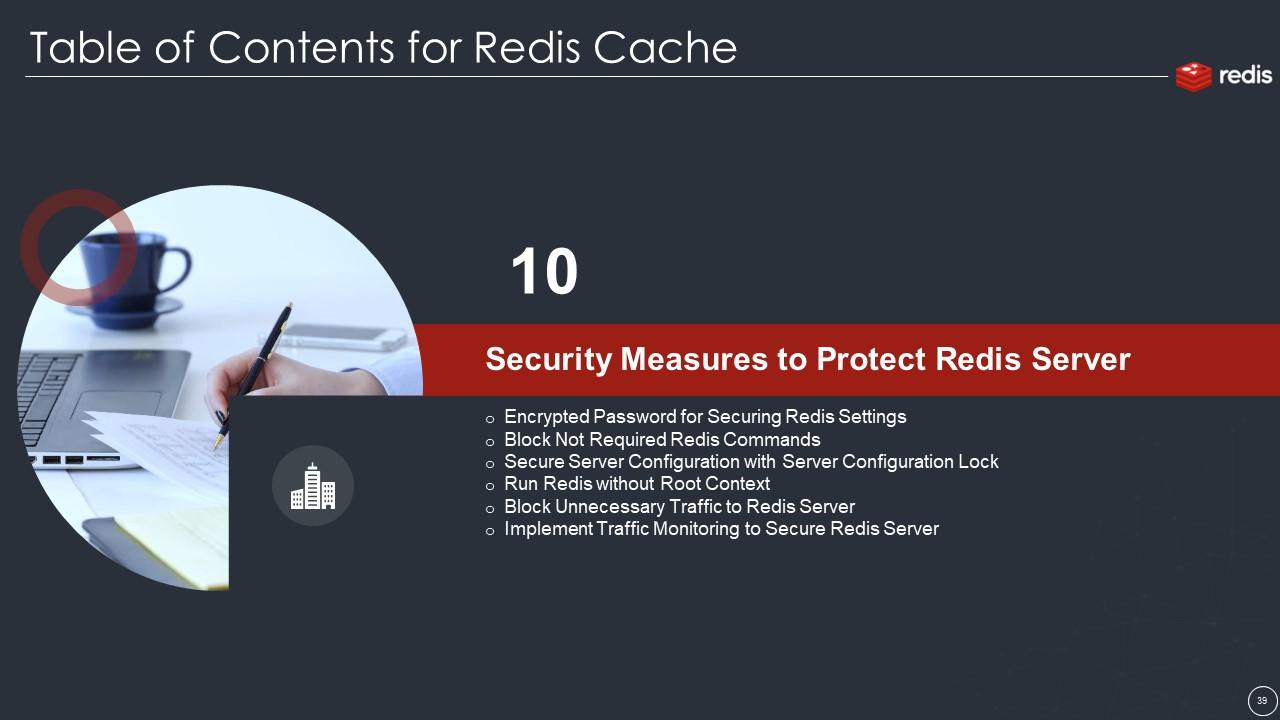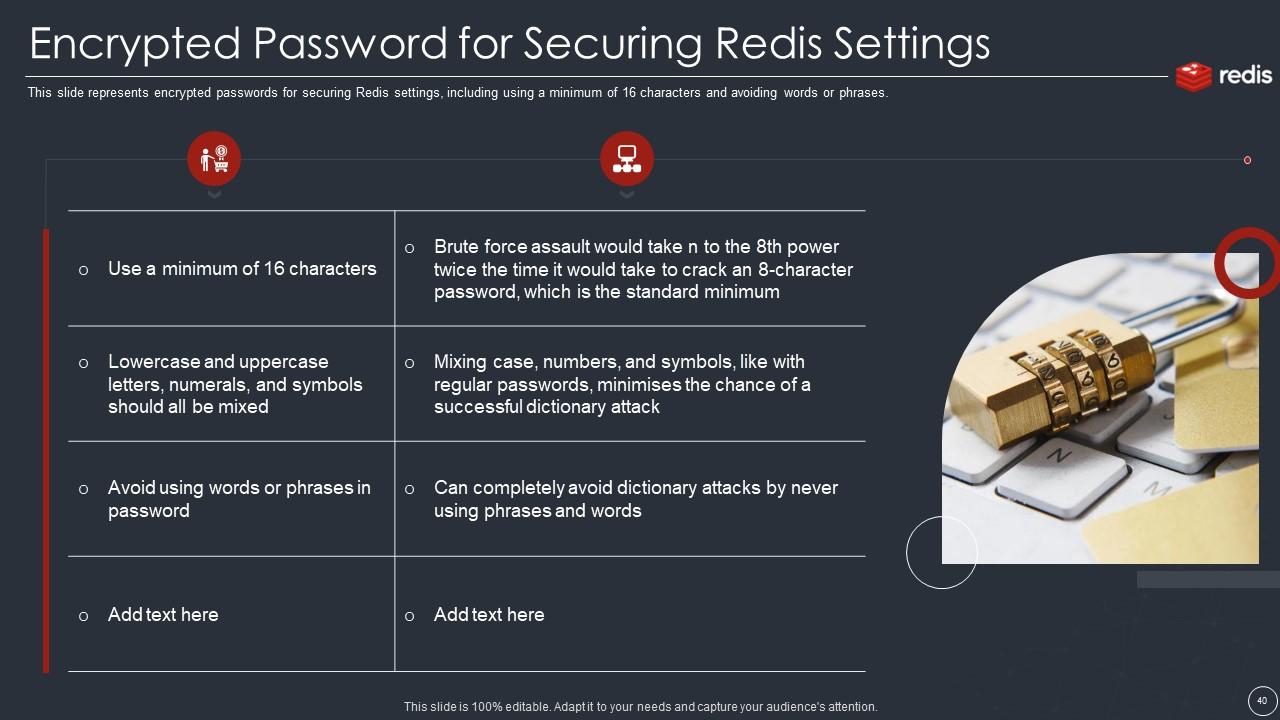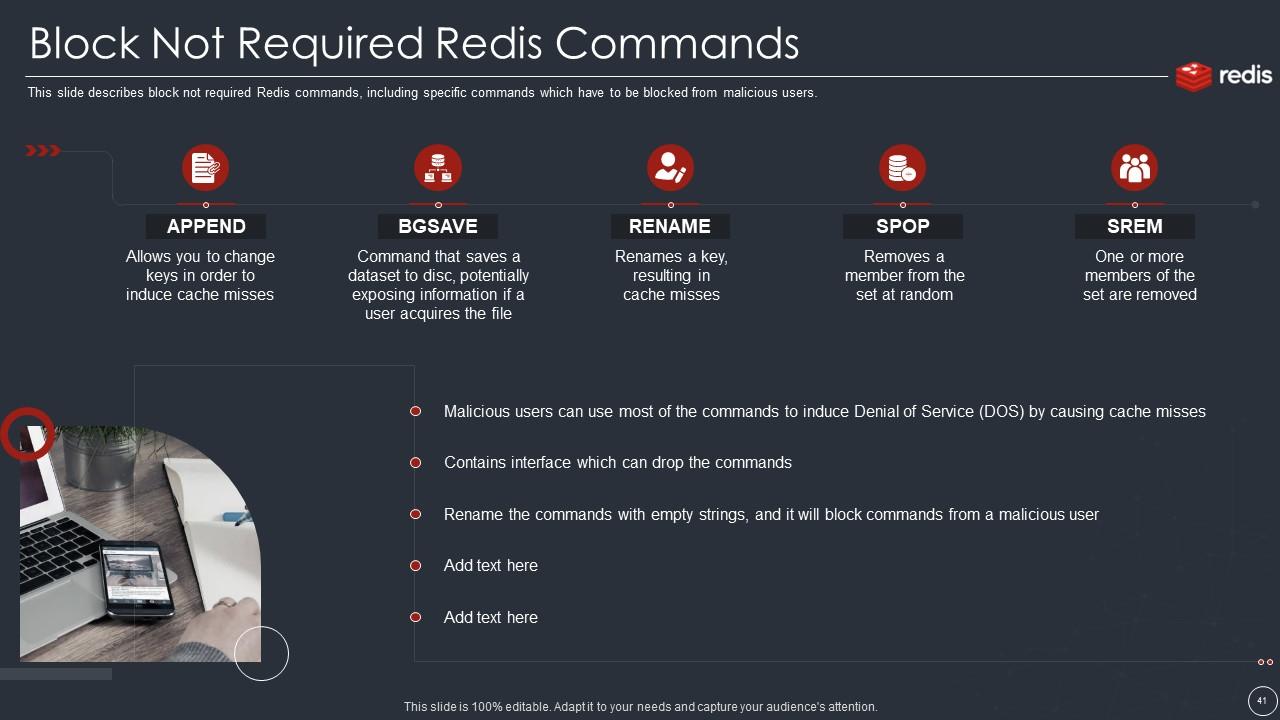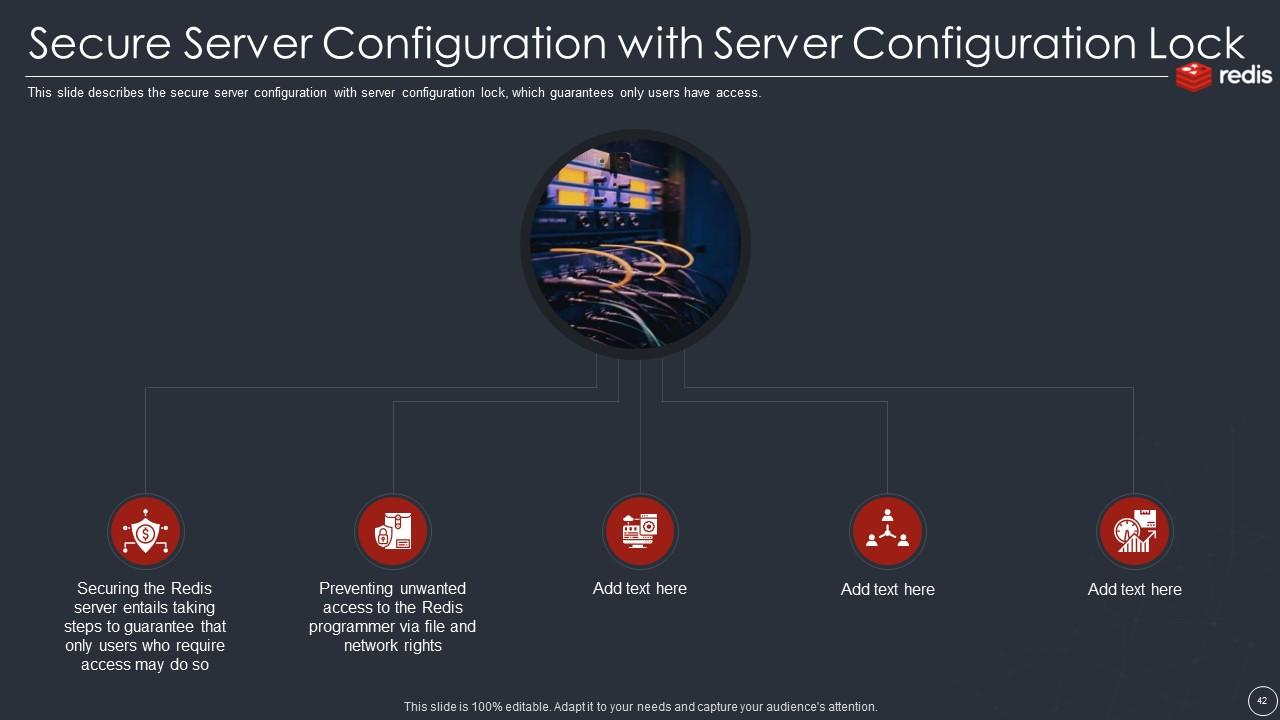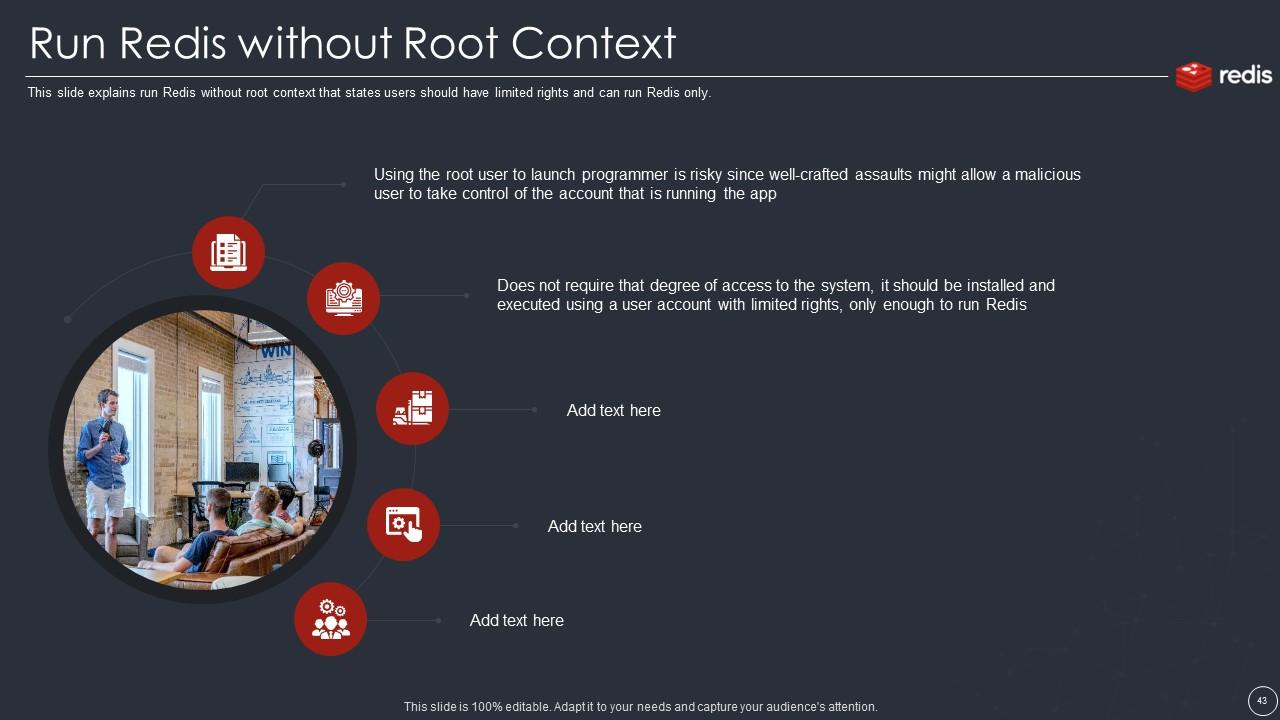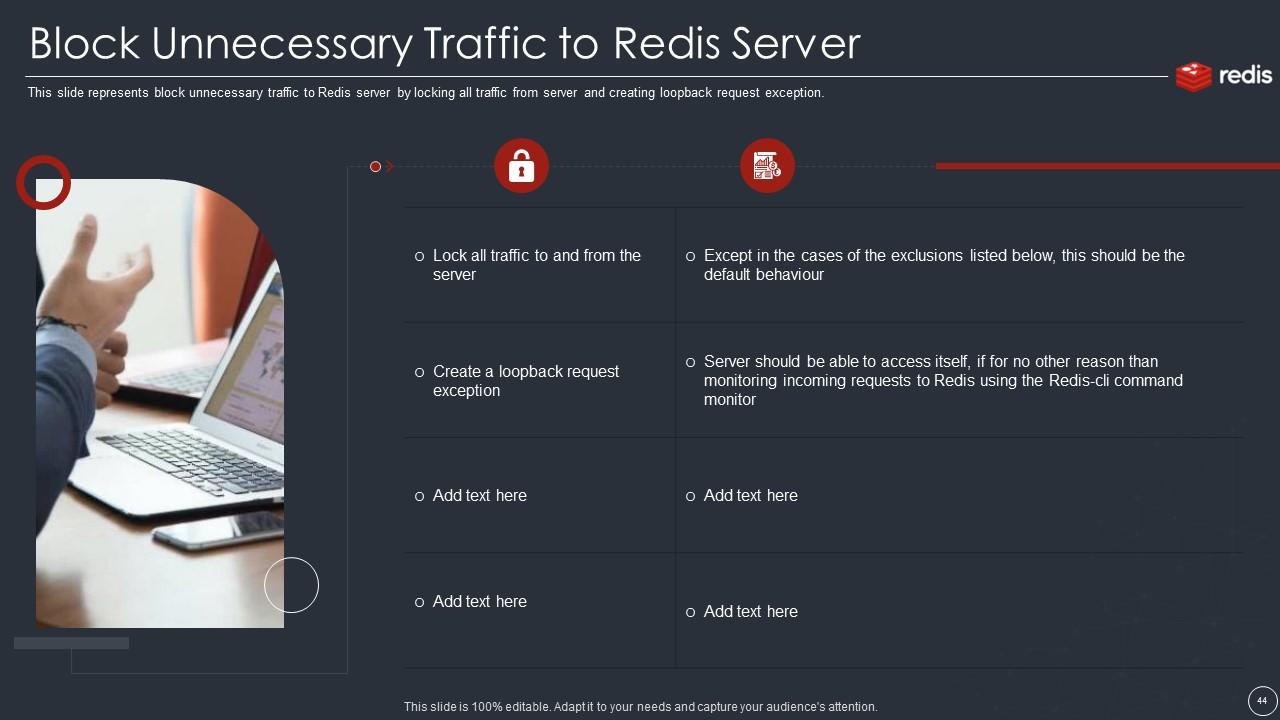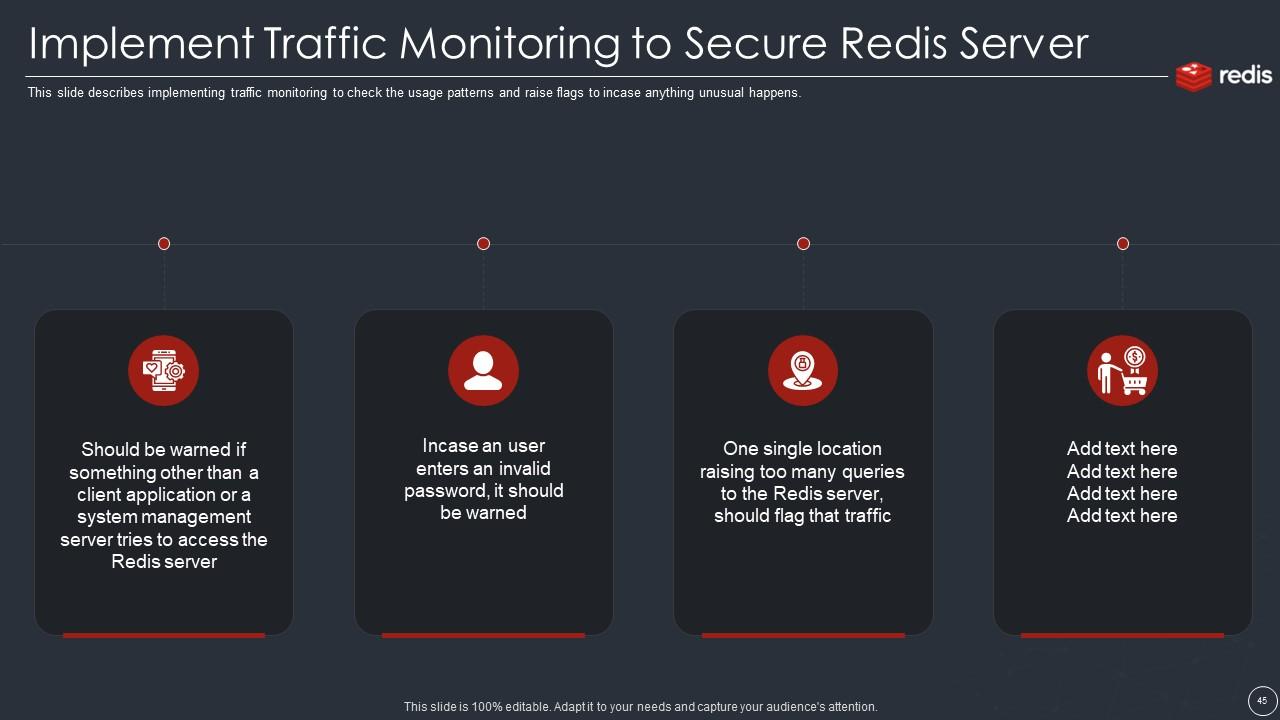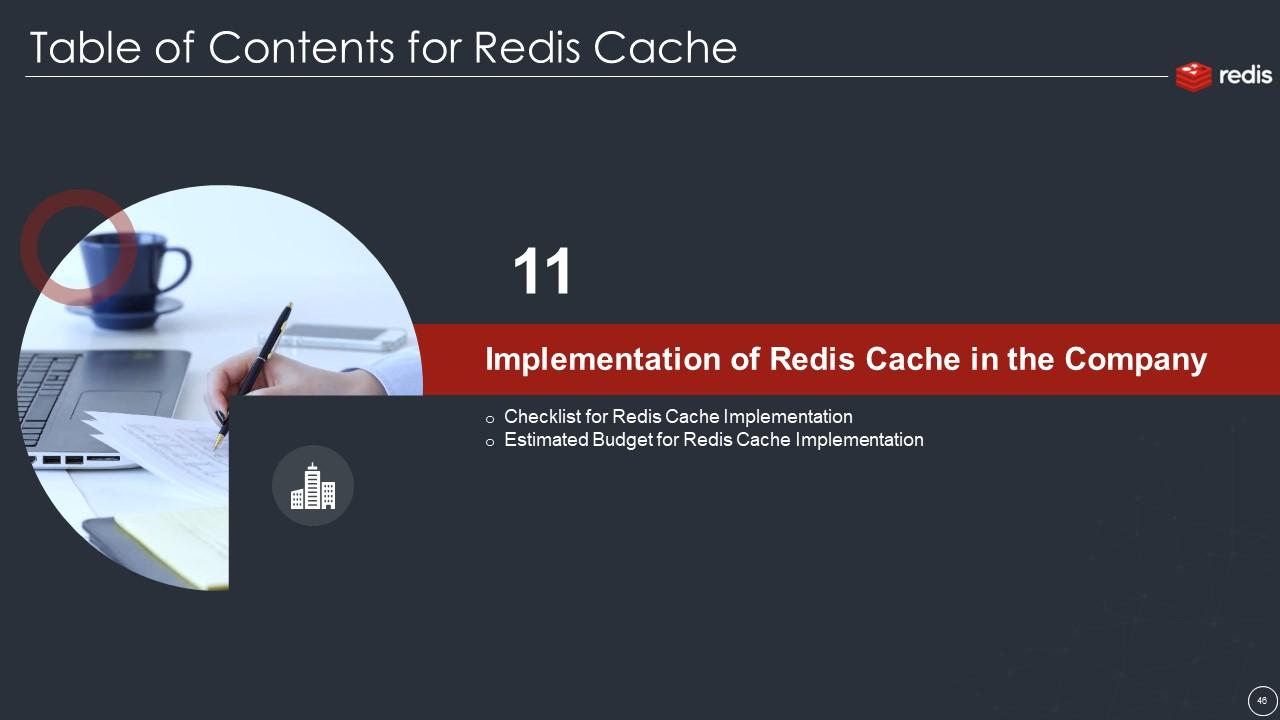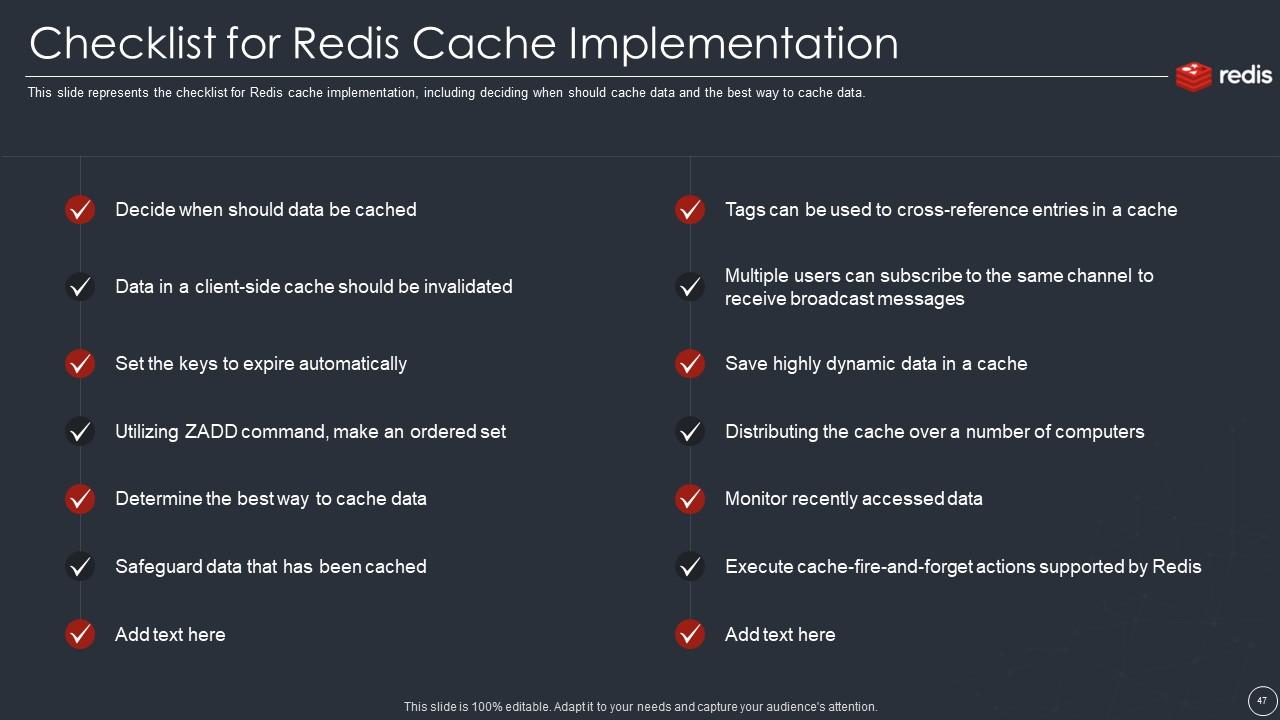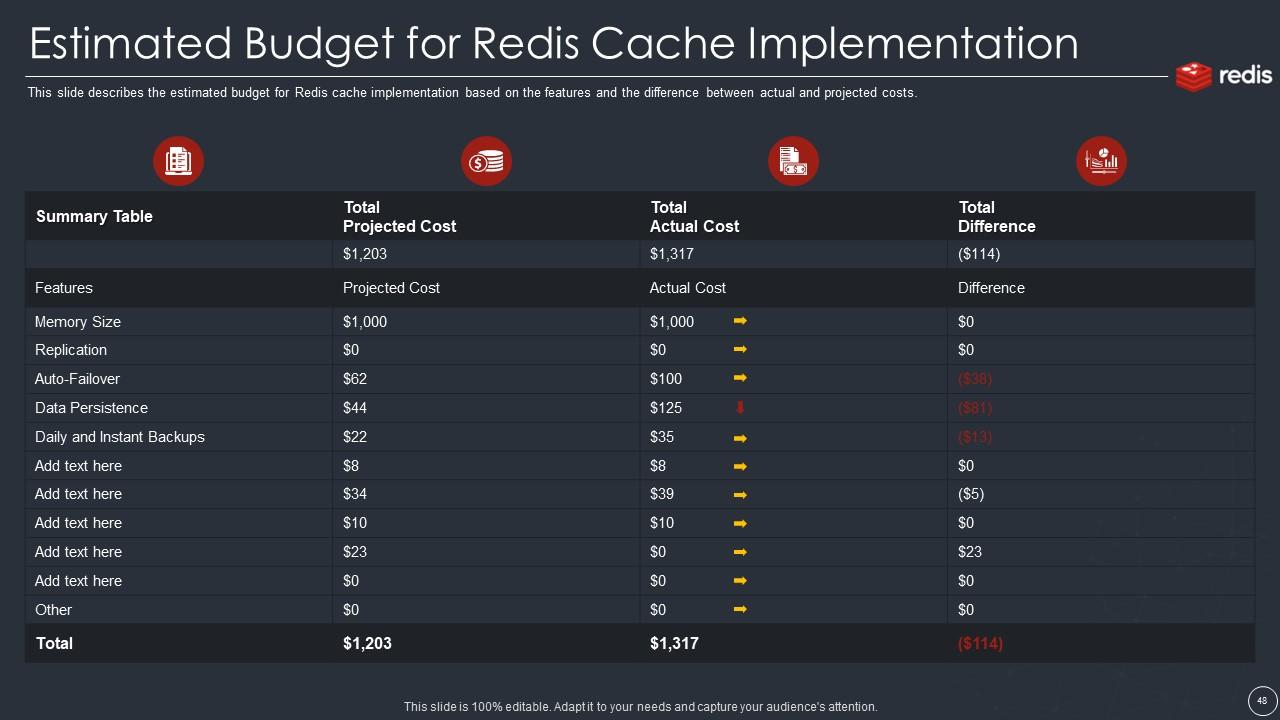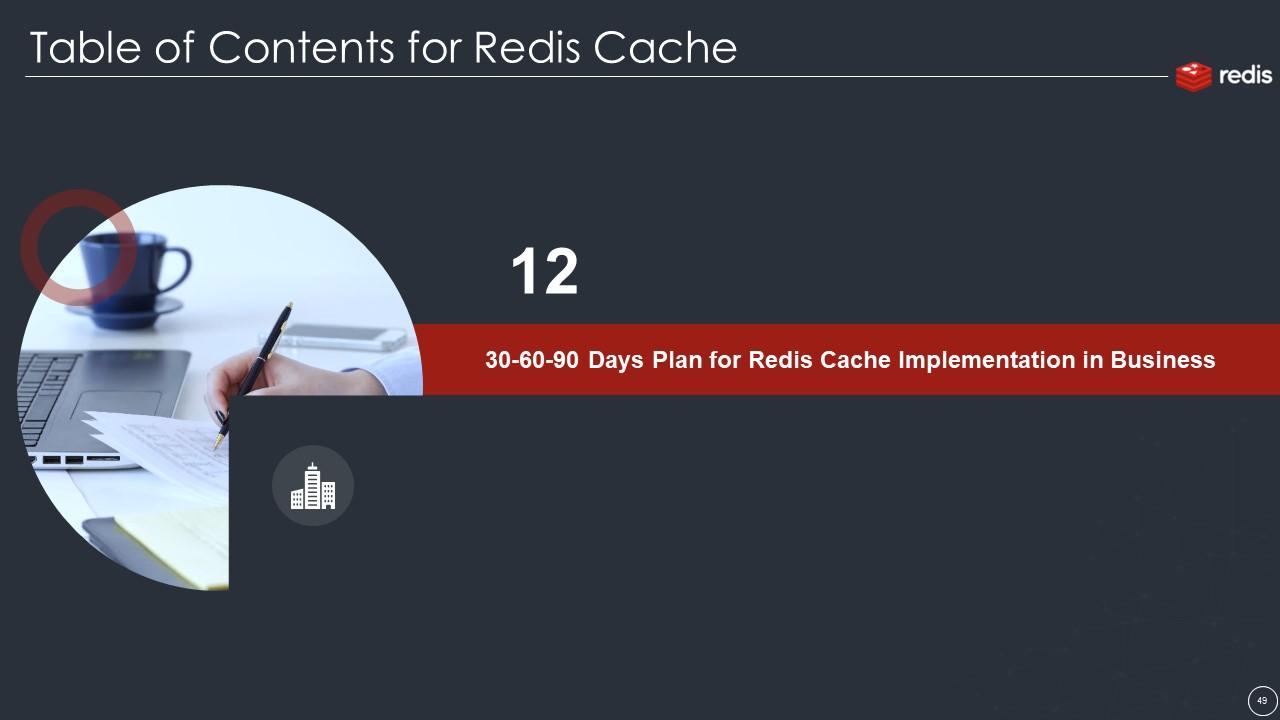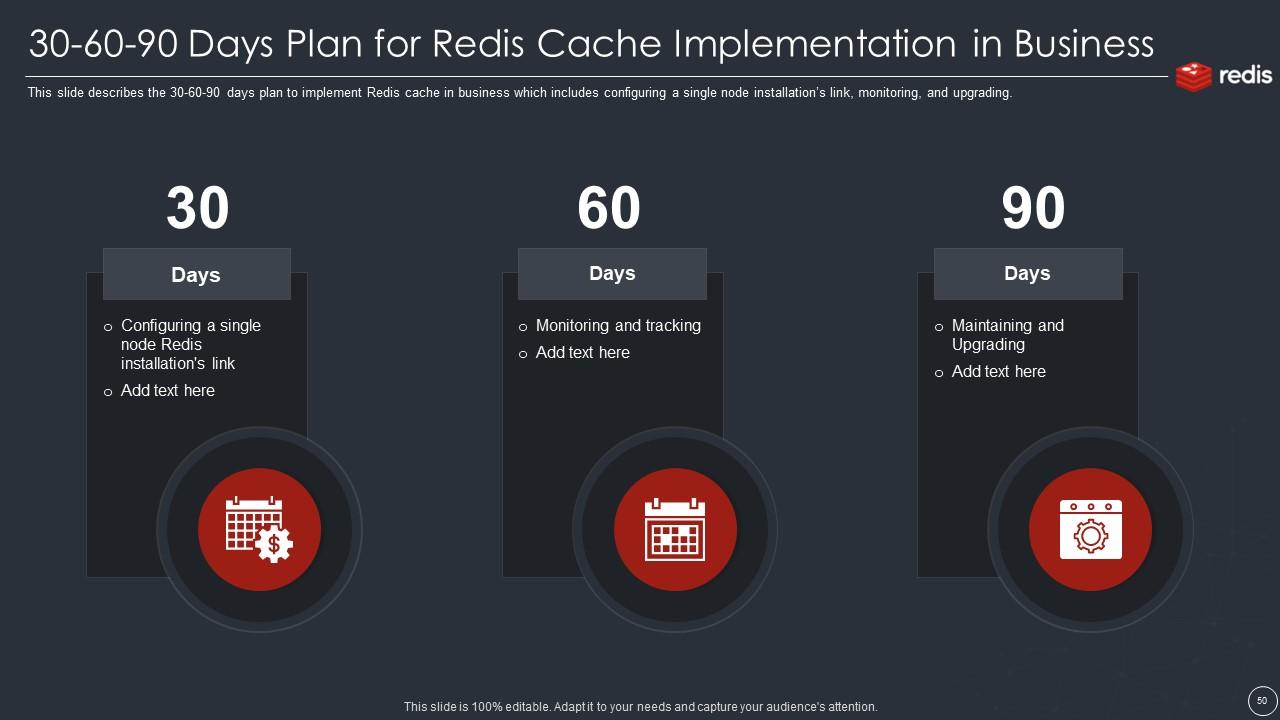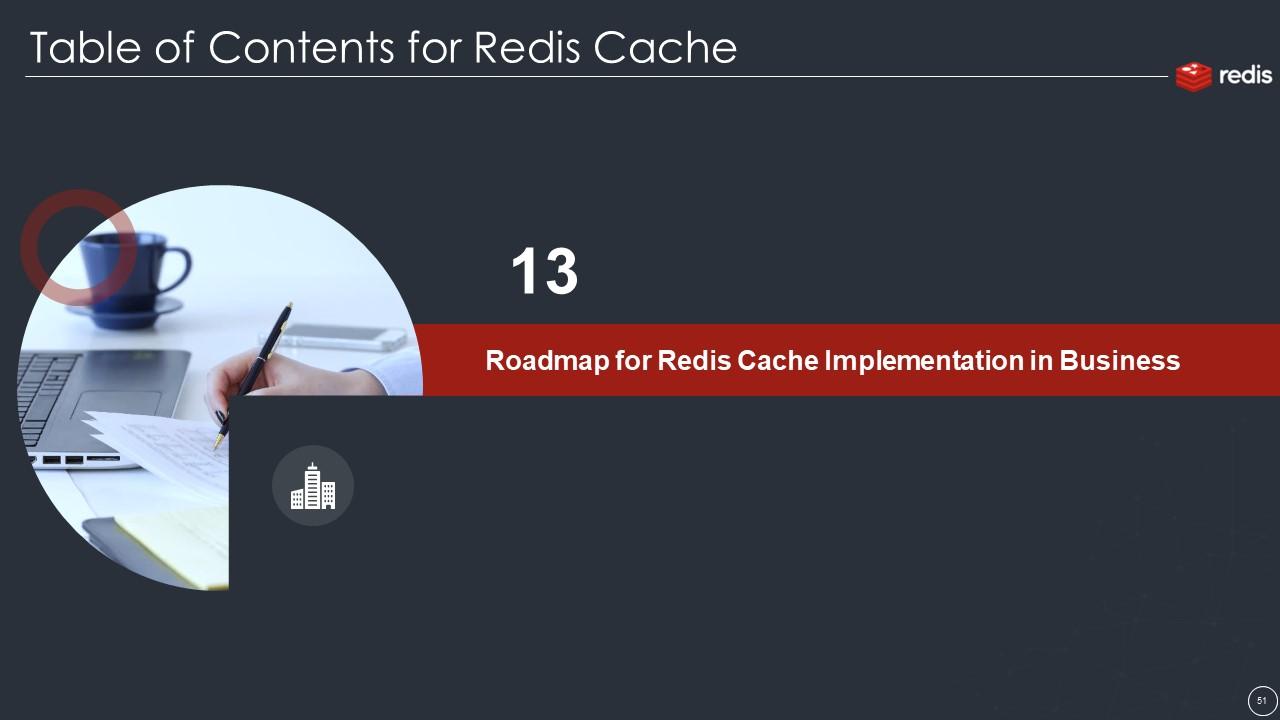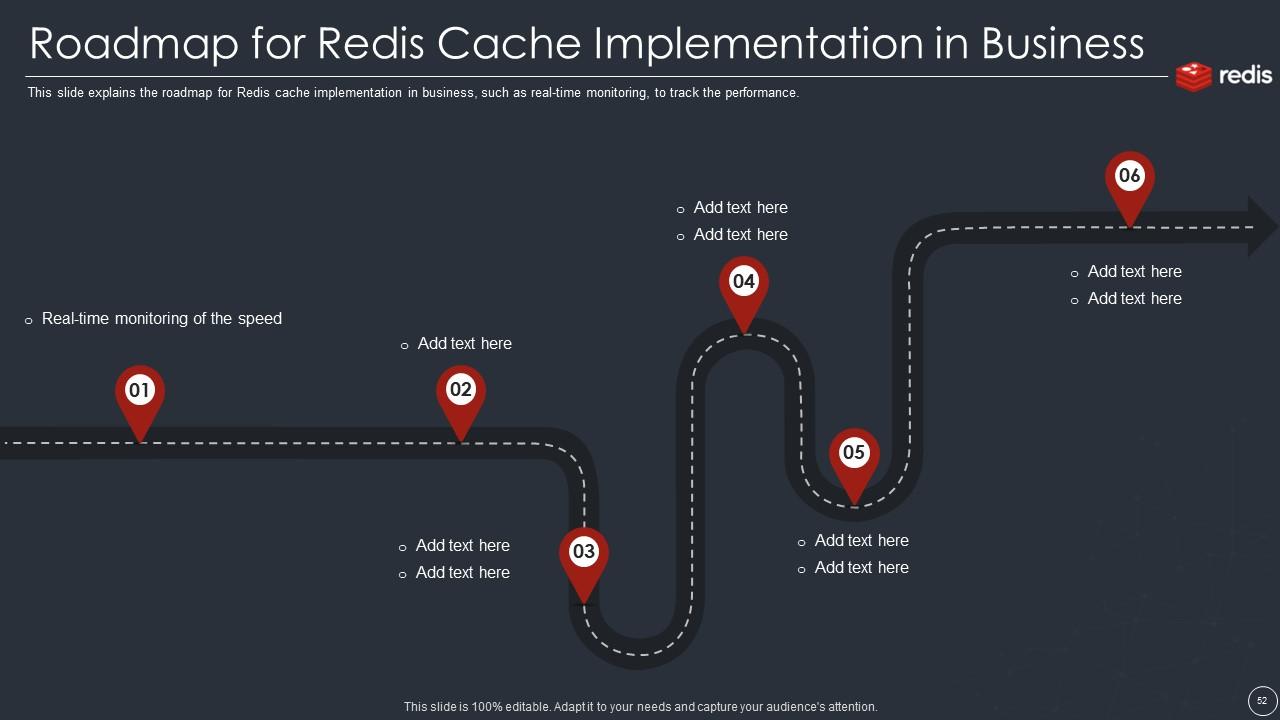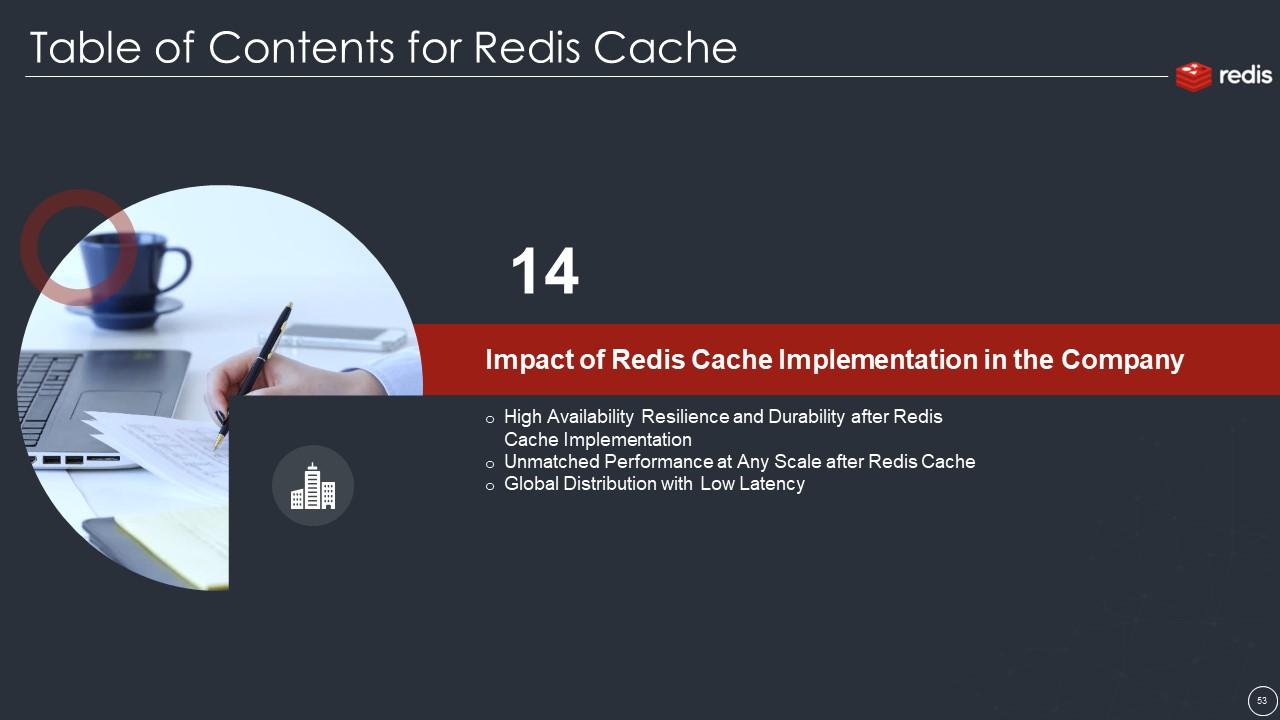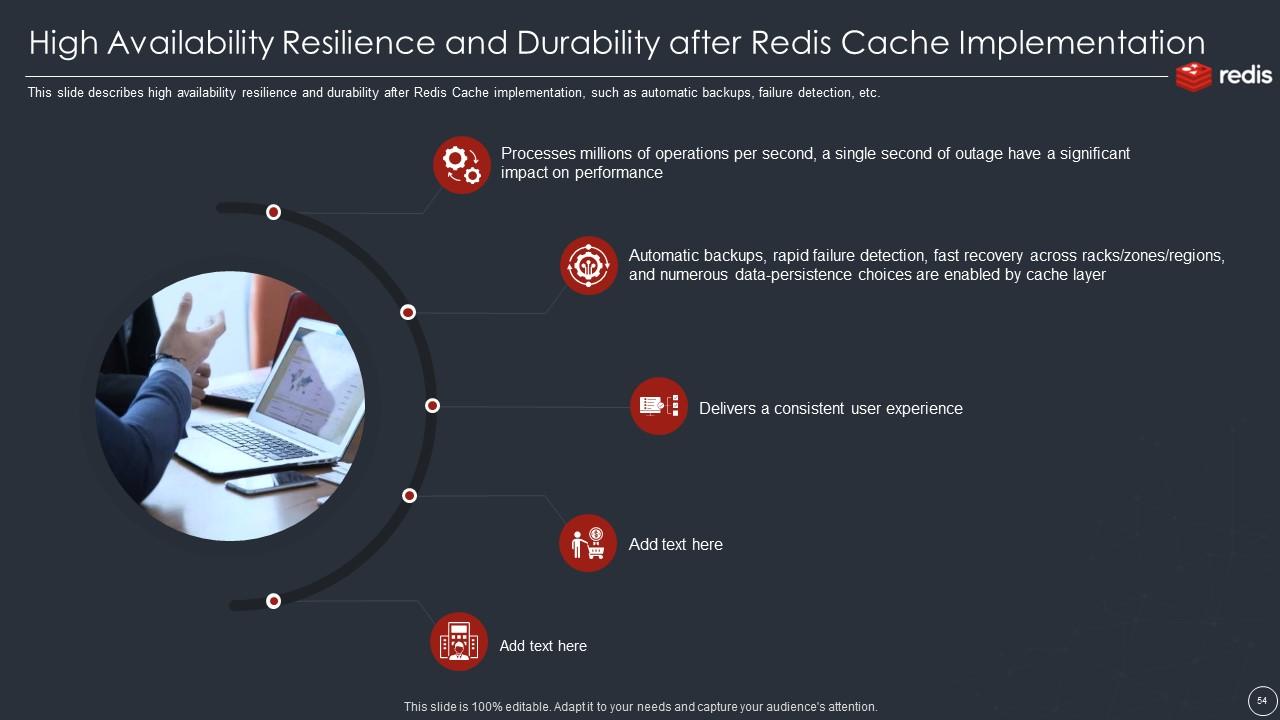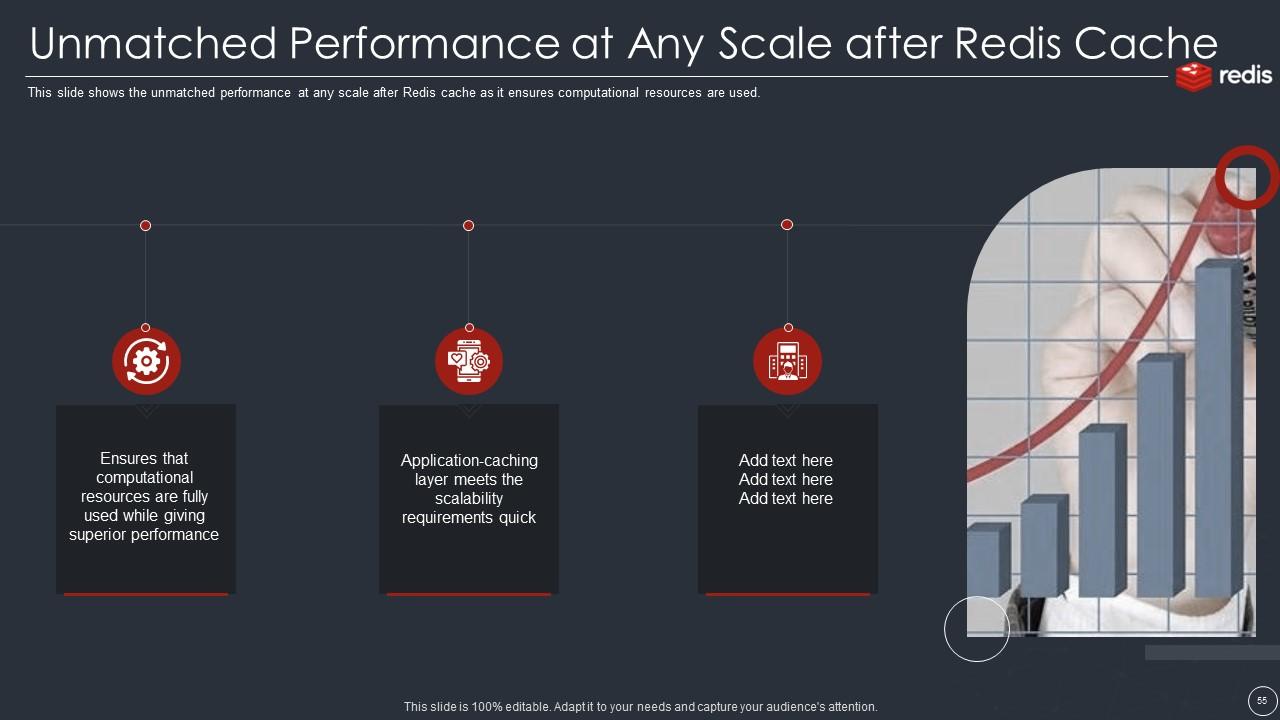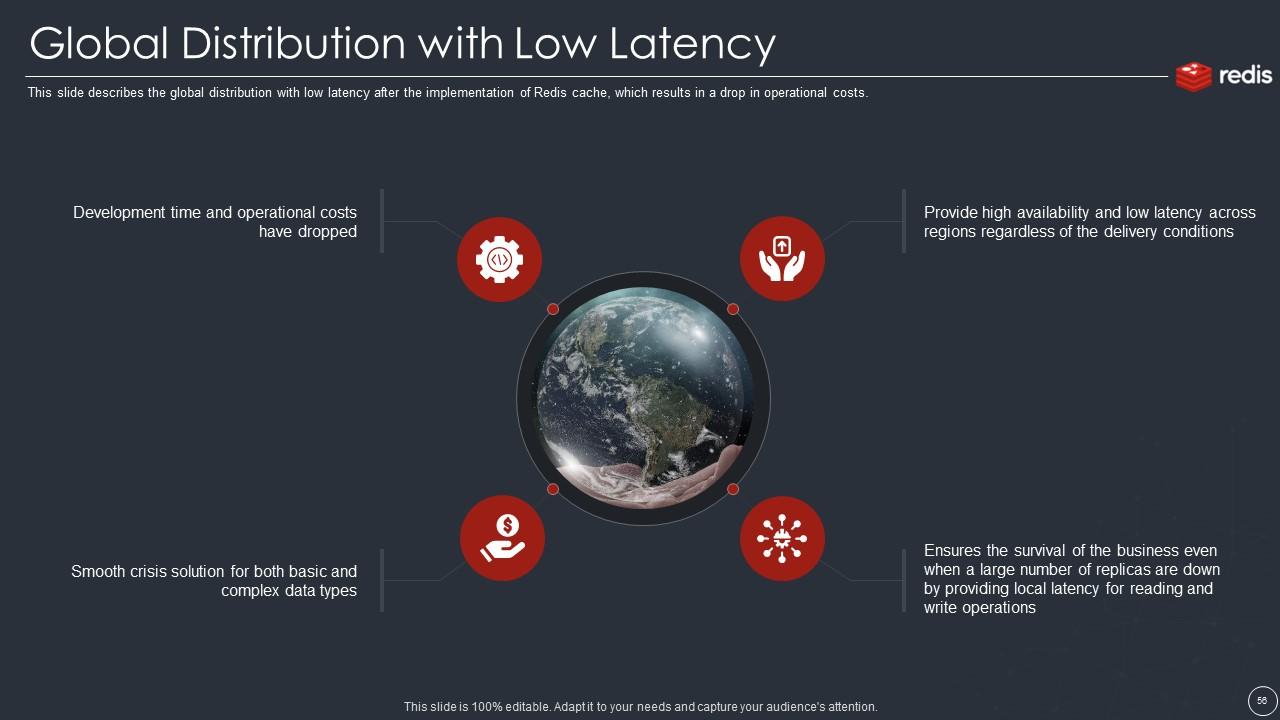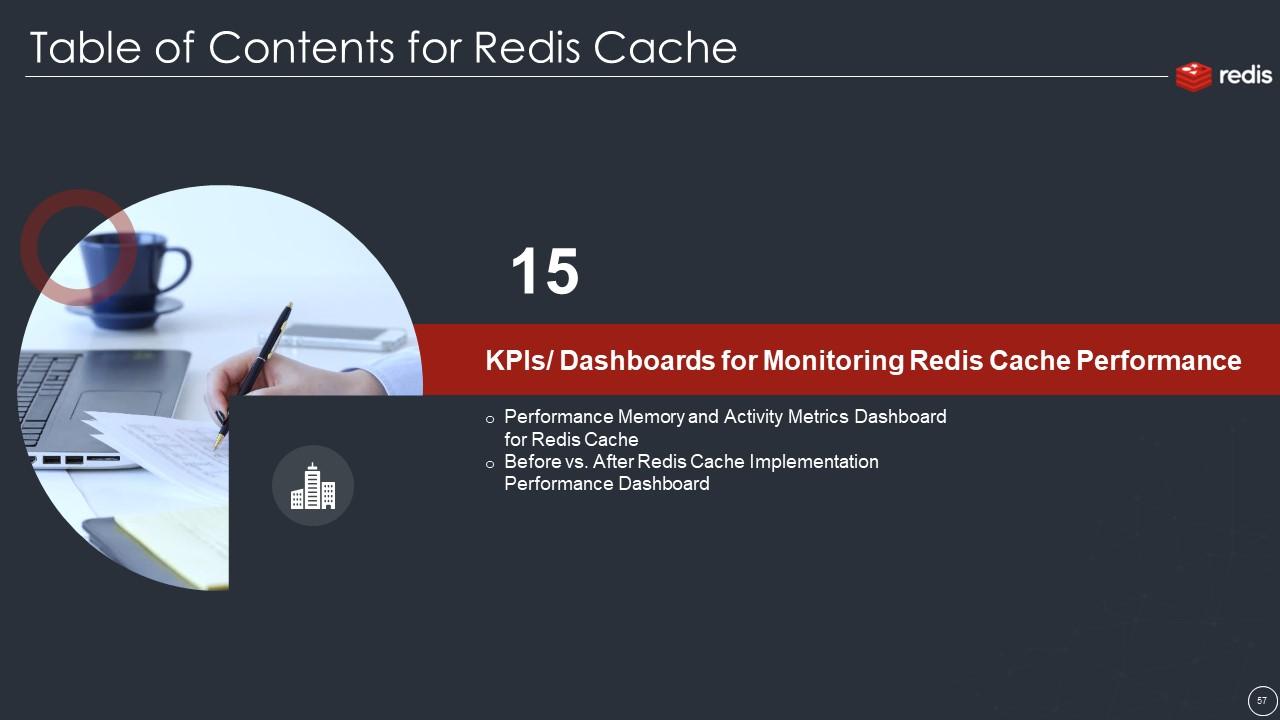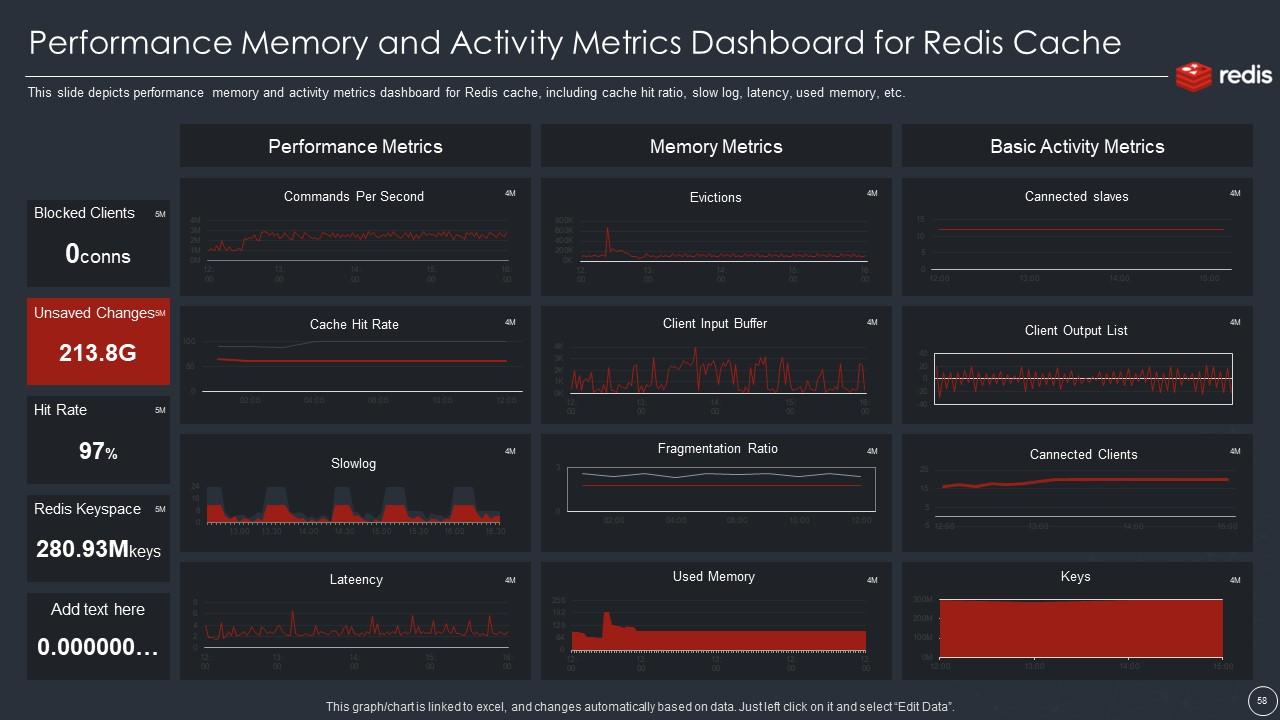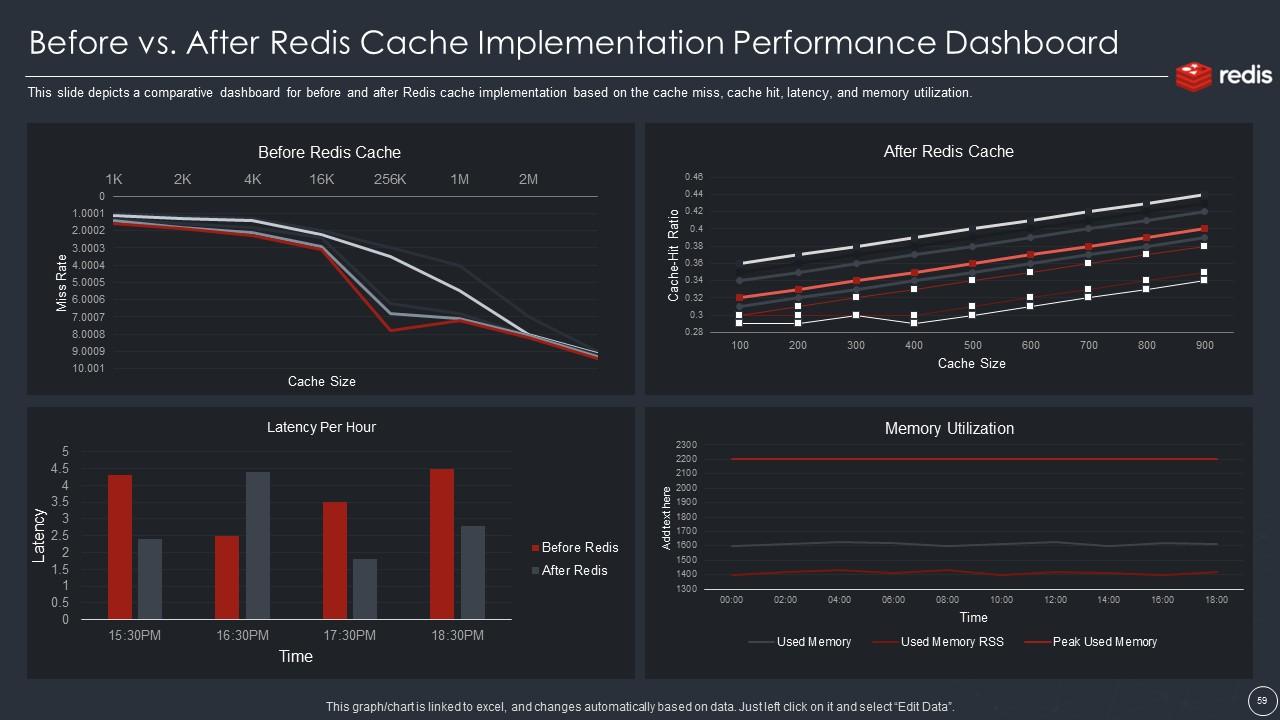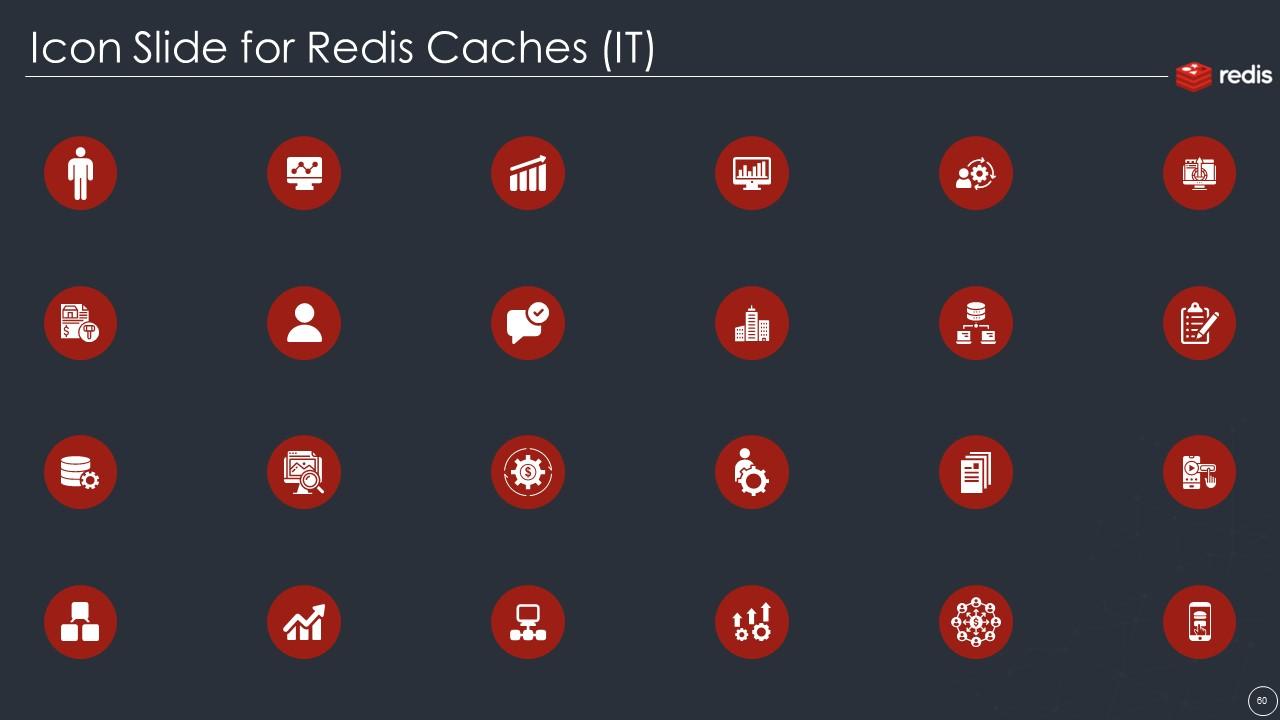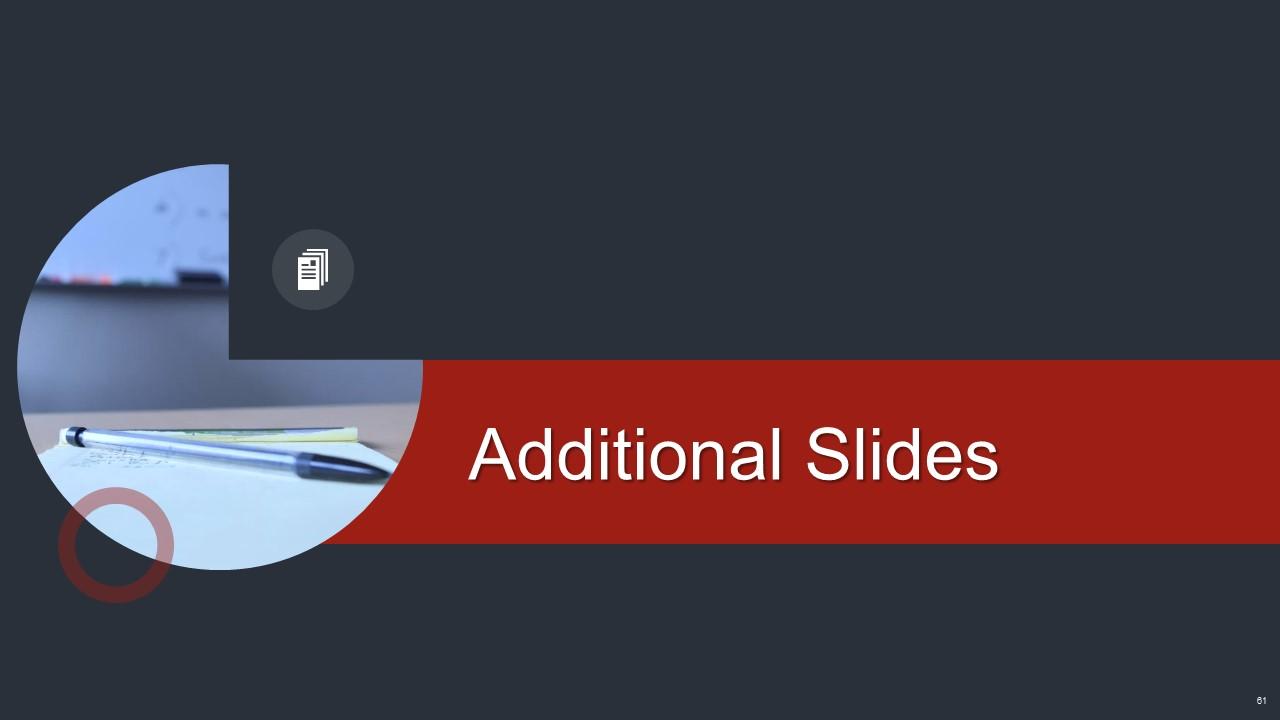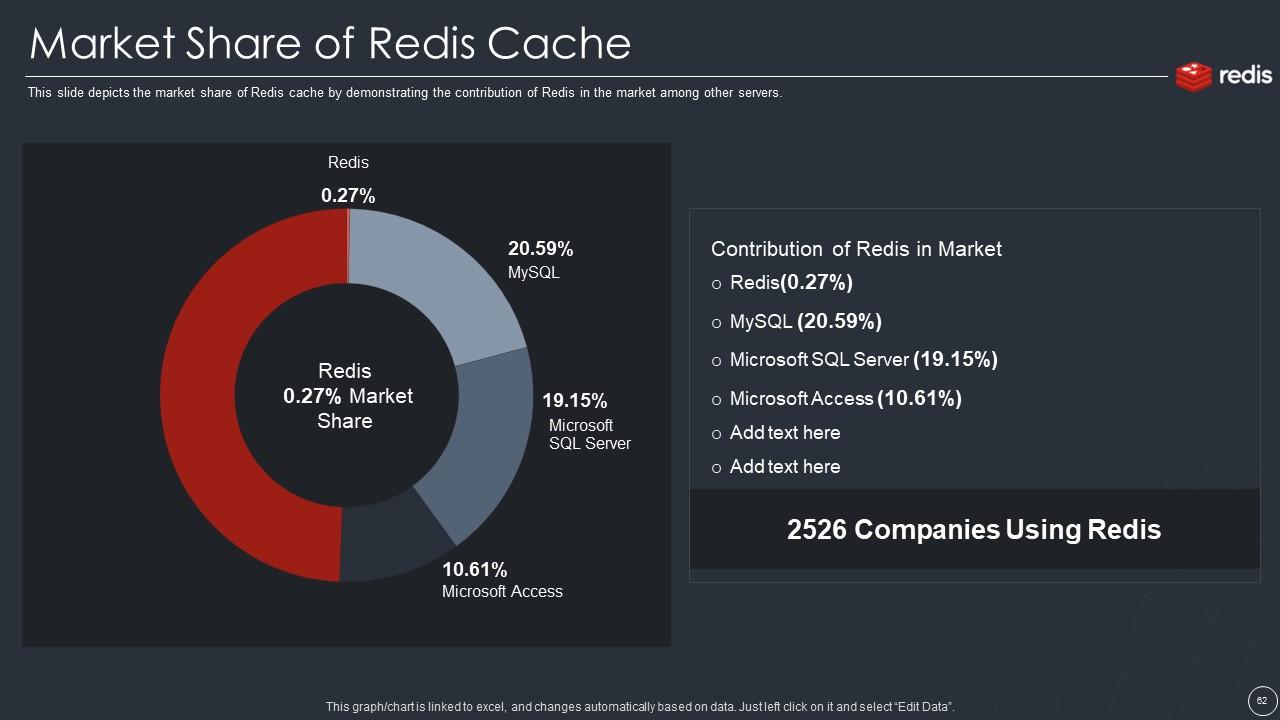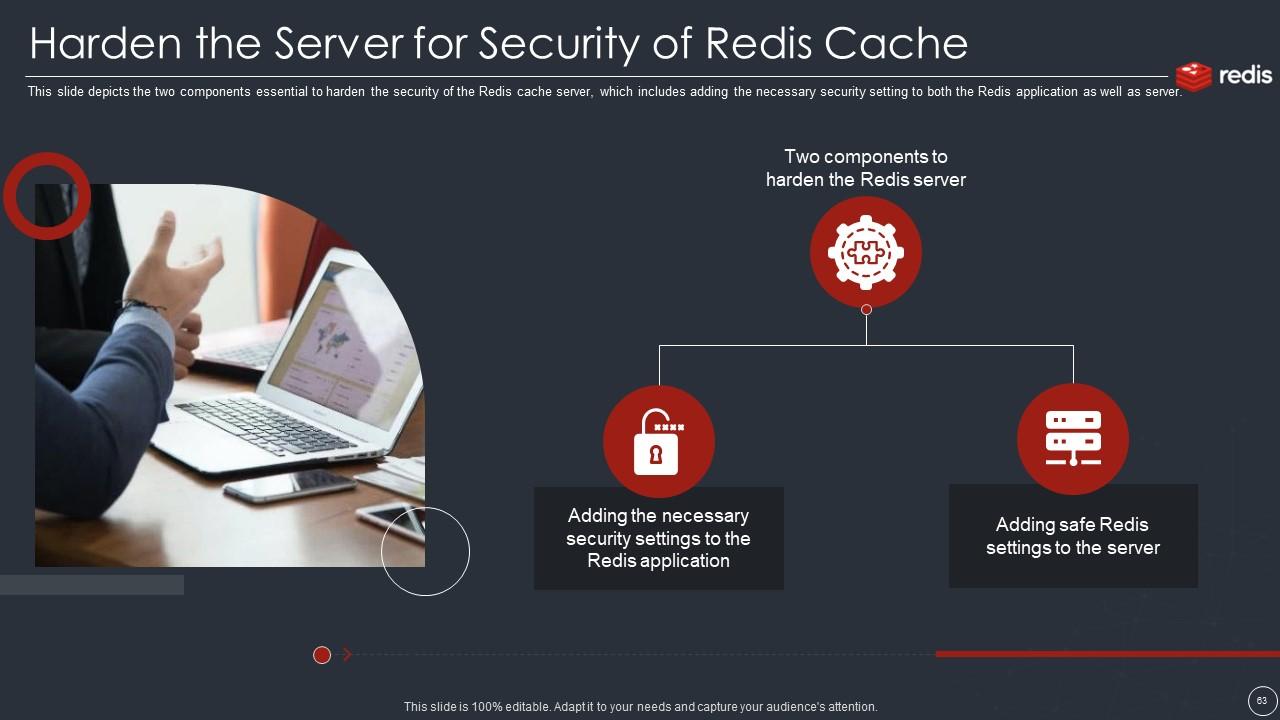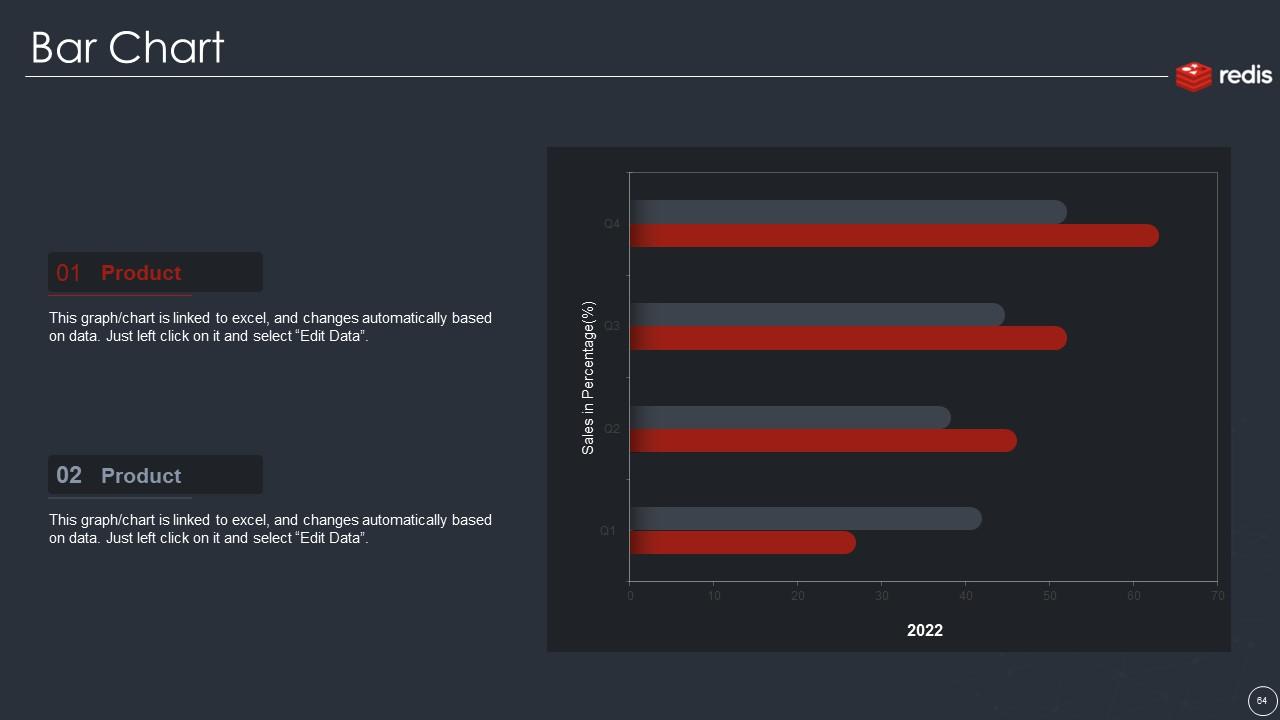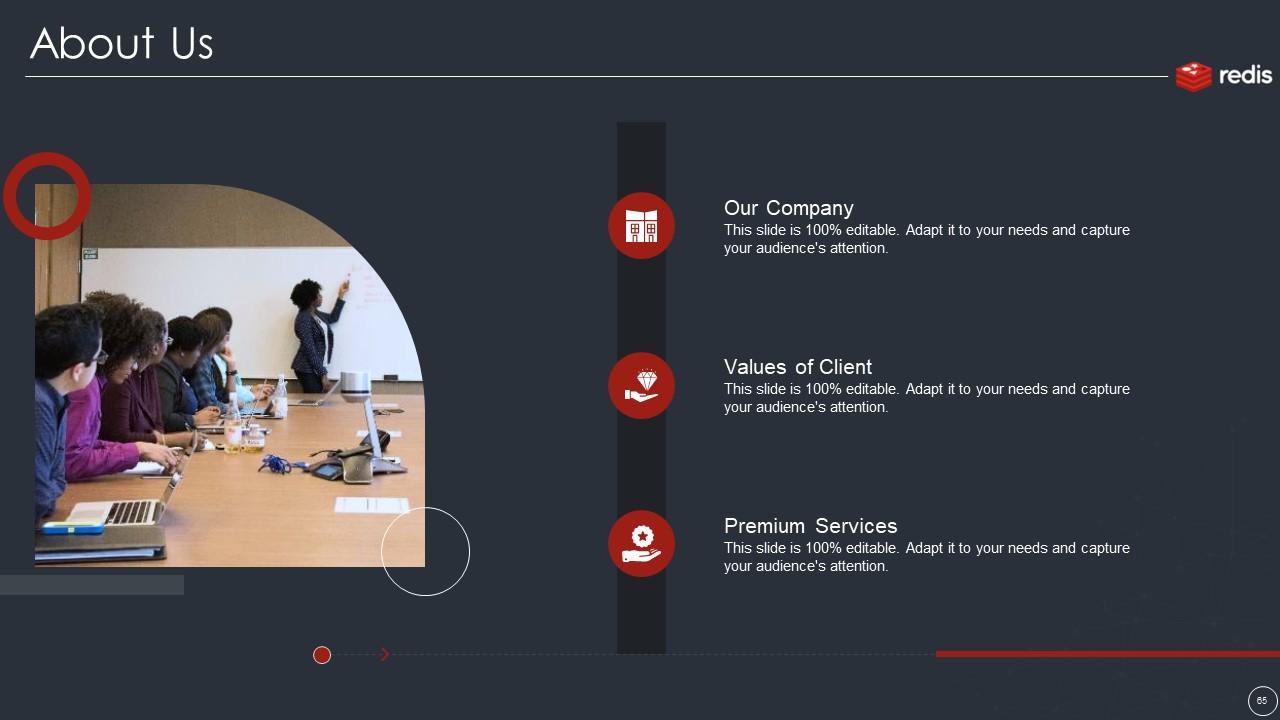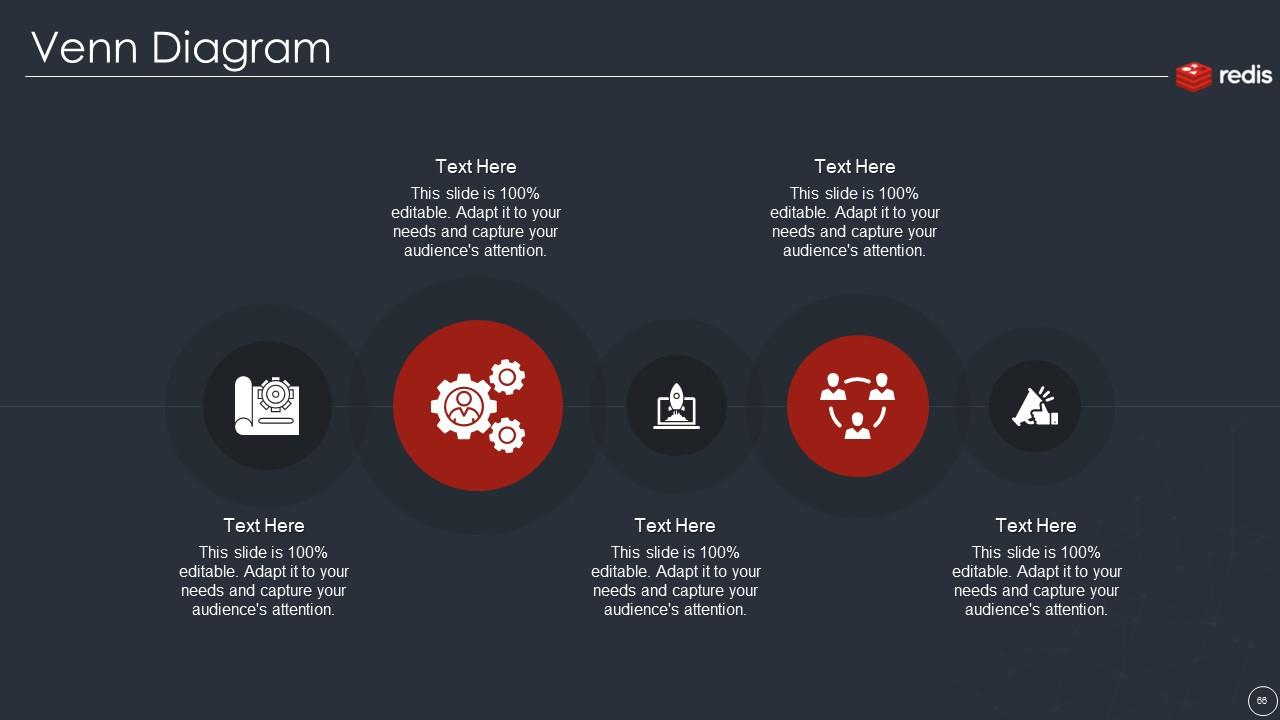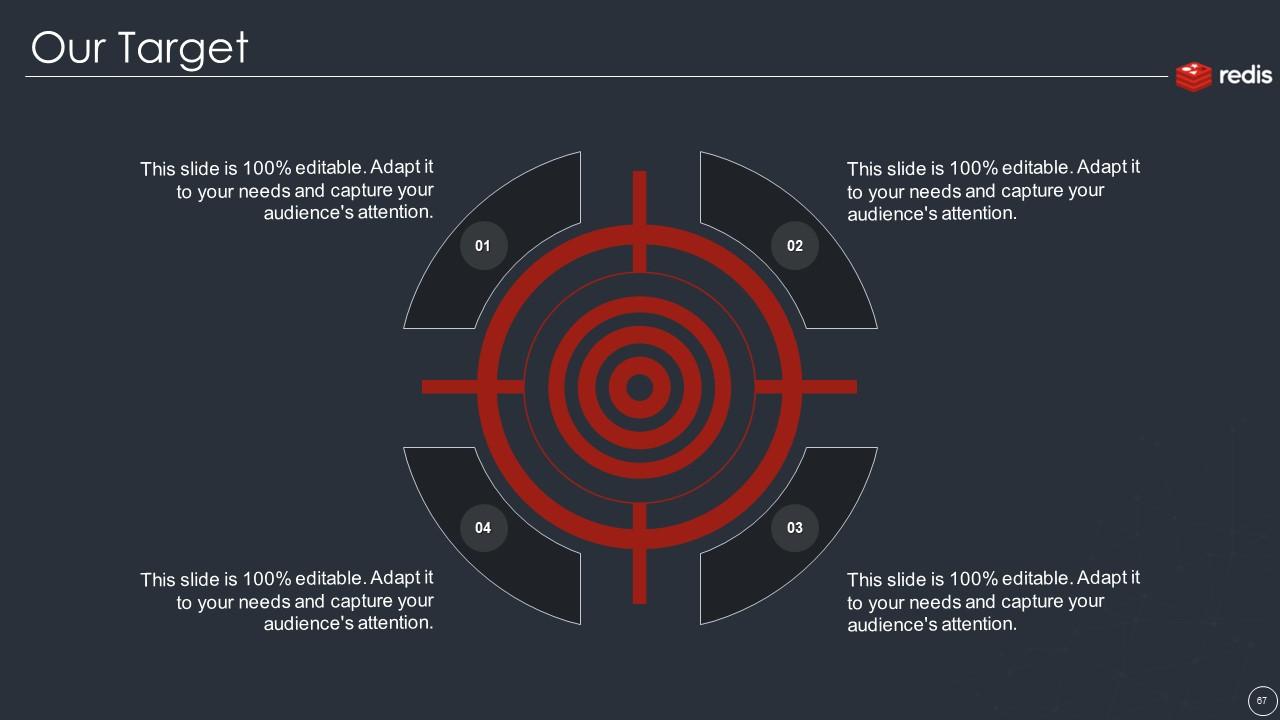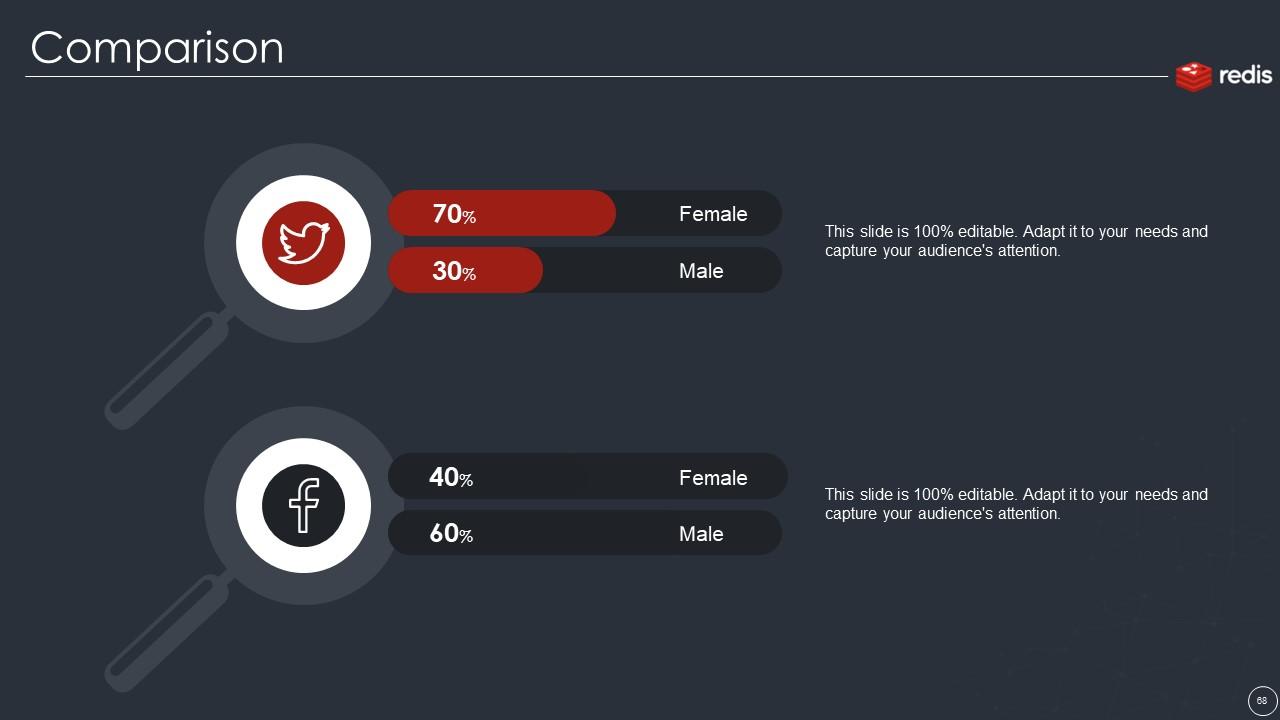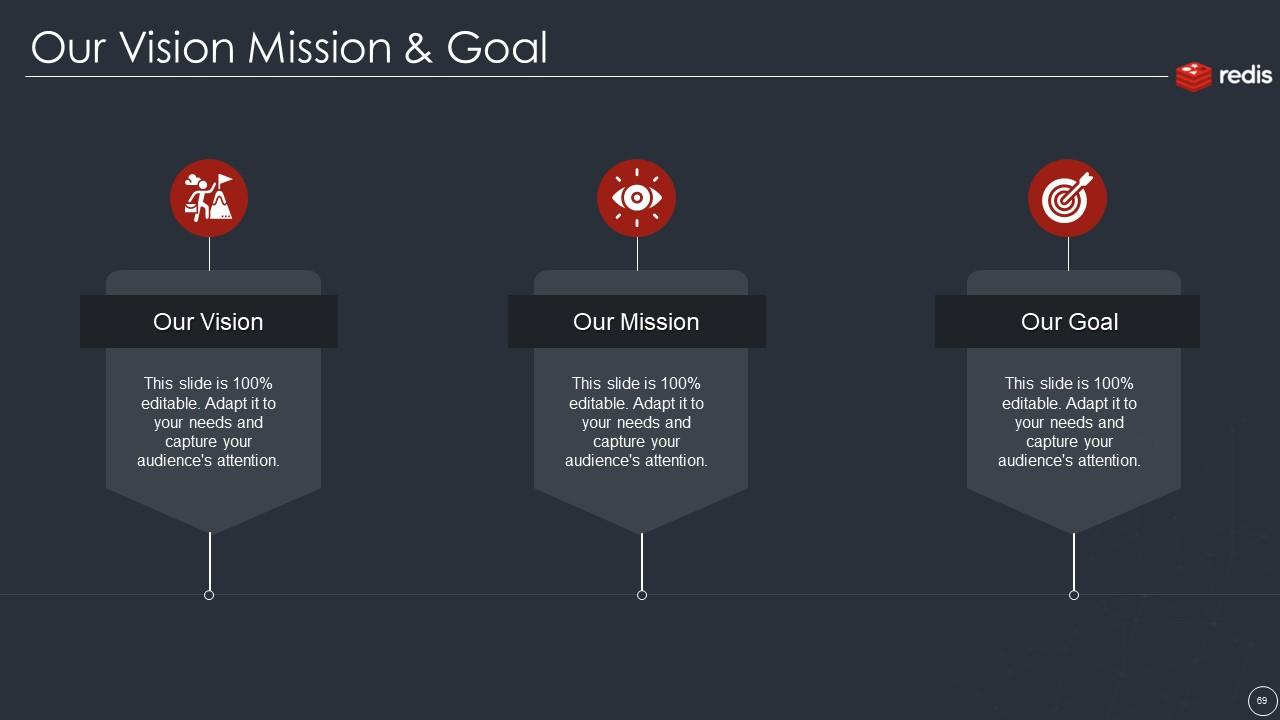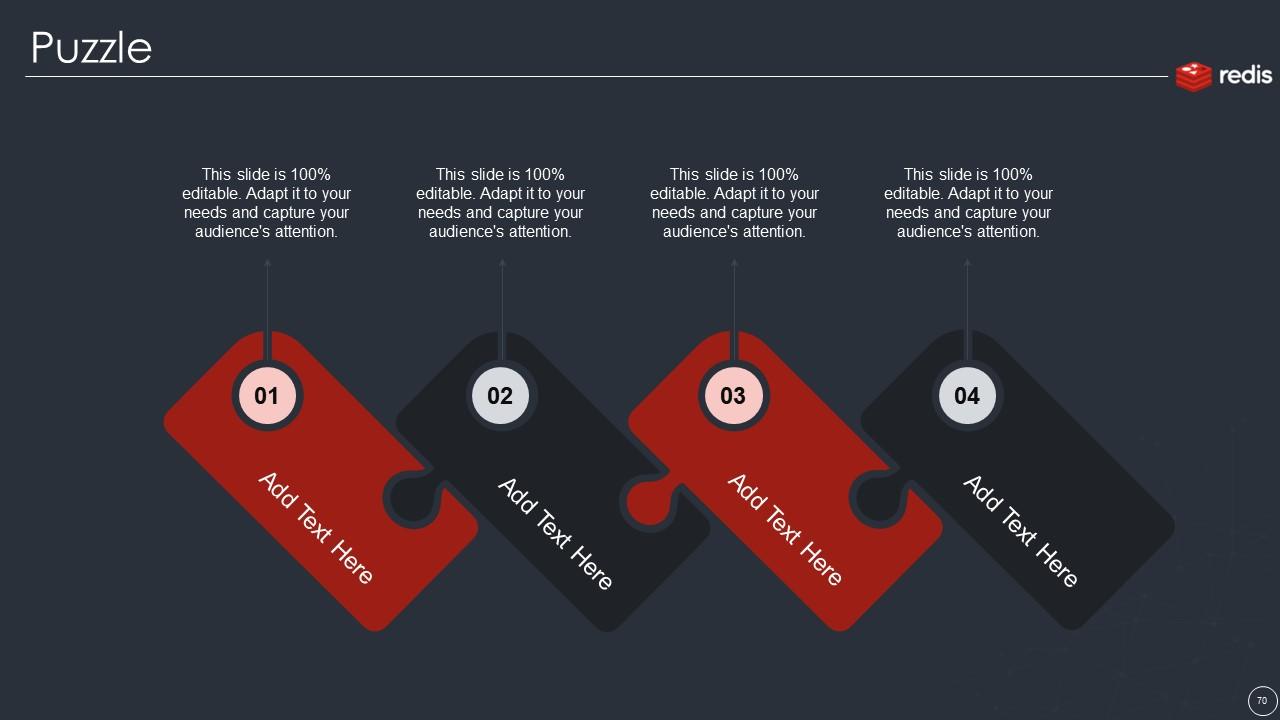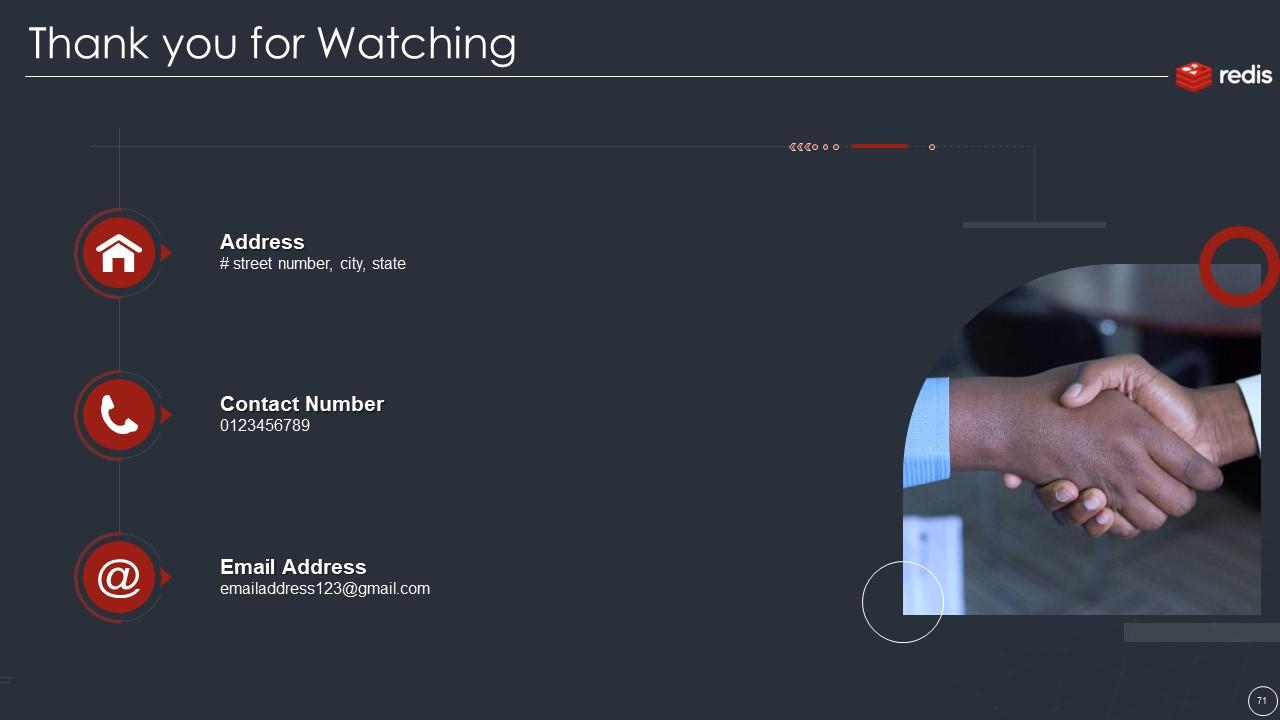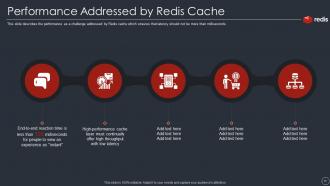Redis caches it powerpoint presentation slides
Redis Remote Directory Server is a data model store that resides in memory. Its a disk-permanent key-value database that can handle a variety of data formats and data kinds. Check out our competently designed Redis Cache IT template that shows Redis cache, its benefits, implementation to eliminate business problems such as delay in retrieving data and poor performance. In this PowerPoint presentation, we have covered the introduction to Redis cache, including its features, architecture, and working. In addition, PPT shows the difference between Redis and other database systems such as Memcached, Mongo DB, and Hbase. Moreover, this presentation represents the data structure of Redis by covering various data structures, which include hashes, strings, and sets as data types supported by Redis cache. Further, the template caters to the security measures to protect the Redis server, a cache implementation checklist, and an estimated budget. Lastly, the deck comprises a 30-60-90-days plan, roadmap, and dashboard to measure the performance and impact of the Redis implementation in the organization. Customize this 100 percent editable template now.
Redis Remote Directory Server is a data model store that resides in memory. Its a disk-permanent key-value database that ca..
- Google Slides is a new FREE Presentation software from Google.
- All our content is 100% compatible with Google Slides.
- Just download our designs, and upload them to Google Slides and they will work automatically.
- Amaze your audience with SlideTeam and Google Slides.
-
Want Changes to This PPT Slide? Check out our Presentation Design Services
- WideScreen Aspect ratio is becoming a very popular format. When you download this product, the downloaded ZIP will contain this product in both standard and widescreen format.
-

- Some older products that we have may only be in standard format, but they can easily be converted to widescreen.
- To do this, please open the SlideTeam product in Powerpoint, and go to
- Design ( On the top bar) -> Page Setup -> and select "On-screen Show (16:9)” in the drop down for "Slides Sized for".
- The slide or theme will change to widescreen, and all graphics will adjust automatically. You can similarly convert our content to any other desired screen aspect ratio.
Compatible With Google Slides

Get This In WideScreen
You must be logged in to download this presentation.
PowerPoint presentation slides
Enthrall your audience with this Redis Caches IT Powerpoint Presentation Slides. Increase your presentation threshold by deploying this well-crafted template. It acts as a great communication tool due to its well-researched content. It also contains stylized icons, graphics, visuals etc, which make it an immediate attention-grabber. Comprising seventy one slides, this complete deck is all you need to get noticed. All the slides and their content can be altered to suit your unique business setting. Not only that, other components and graphics can also be modified to add personal touches to this prefabricated set.
People who downloaded this PowerPoint presentation also viewed the following :
Content of this Powerpoint Presentation
Slide 1: This slide displays title i.e. 'Redis Caches (IT)' and your Company Name.
Slide 2: This slide presents agenda.
Slide 3: This slide exhibits table of contents.
Slide 4: This slide also shows table of contents.
Slide 5: This slide depicts title for two topics that are to be covered next in the template.
Slide 6: This slide depicts that due to poor user experience company is converting even less than 5% of its traffic into new business opportunities.
Slide 7: This slide highlights the revenue loss faced by the company due to poor experience faced by users, which is estimated to be $62 billion every year.
Slide 8: This slide depicts title for three topics that are to be covered next in the template.
Slide 9: This slide depicts the importance of Redis Cache in the company based on real-time analysis, easier development of location-based applications, etc.
Slide 10: This slide describes the benefits of Redis cache in business such as speed, replication of data, and multi-purpose tool.
Slide 11: This slide depicts the reasons for which we need Redis, such as to reduce the pressure on JVM(Java Virtual Machine) heap and so on.
Slide 12: This slide depicts title for four topics that are to be covered next in the template.
Slide 13: This slide explains sentinel as a feature of Redis cache to be implemented that includes replication of data and its capability.
Slide 14: This slide describes cluster feature of Redis to be implemented which involves distributed Redis implementation that separates datasets into nodes.
Slide 15: This slide depicts pub/sub feature of Redis which allows users to create high-performance conversations and message service across all applications.
Slide 16: This slide explains persistence feature of Redis cache to be implemented which includes keeping databases alive by taking screenshots.
Slide 17: This slide depicts title for two topics that are to be covered next in the template.
Slide 18: This slide demonstrates the architecture of Redis cache which mainly consists of Redis client and Redis server, etc.
Slide 19: This slide describes the working of the Redis cache by demonstrating the time span of a user to access data with and without Redis Cache.
Slide 20: This slide depicts title for two topics that are to be covered next in the template.
Slide 21: This slide describes the overview of application caching which insists on keeping copies of the most frequently used data on ephemeral.
Slide 22: This slide depicts use cases for application caching such as DBMS data storage, user session data, and fast access to responses.
Slide 23: This slide depicts title for five topics that are to be covered next in the template.
Slide 24: This slide depicts the strings data type of Redis cache which is a byte series, and is binary-safe, has a finite size, and may save up to 512MB.
Slide 25: This slide describes harsh as one of the data types of Redis Cache which are defined as a set of standardized pairs, etc.
Slide 26: This slide depicts the linked list data type of Redis in which entries can be inserted into the list either at the beginning or at the end.
Slide 27: This slide demonstrates sets as a data type of Redis cache which includes a group of strings that are not in any typical sequence.
Slide 28: This slide describes the sorted sets data type of Redis in which each sorted sets have a points total, etc.
Slide 29: This slide depicts title for two topics that are to be covered next in the template.
Slide 30: This slide illustrates the applications which use Redis Cache such as Twitter, Dream11(video game), and Pinterest.
Slide 31: This slide describes common use cases of Redis Cache such as session cache, full page cache(FPC), queues, leaderboards, and pub/sub.
Slide 32: This slide depicts title for three topics that are to be covered next in the template.
Slide 33: This slide illustrates the difference between Redis and Memcached based on data types, persistence, data length, and replication.
Slide 34: This slide demonstrates how Redis is different from Mongo DB on the basis of features, scalability, and performance.
Slide 35: This slide illustrates the comparison of Hbase with Redis cache based on the capability of handling records and speed of processing tons of requests.
Slide 36: This slide depicts title for two topics that are to be covered next in the template.
Slide 37: This slide describes the performance as a challenge addressed by Redis cache which ensures that latency should not be more than milliseconds.
Slide 38: This slide represents scalability addressed by Redis cache which is done dynamically without slowing down the response time.
Slide 39: This slide depicts title for six topics that are to be covered next in the template.
Slide 40: This slide represents encrypted passwords for securing Redis settings, including using a minimum of 16 characters and avoiding words or phrases.
Slide 41: This slide describes block not required Redis commands, including specific commands which have to be blocked from malicious users.
Slide 42: This slide describes the secure server configuration with server configuration lock, which guarantees only users have access.
Slide 43: This slide explains run Redis without root context that states users should have limited rights and can run Redis only.
Slide 44: This slide represents block unnecessary traffic to Redis server by locking all traffic from server and creating loopback request exception.
Slide 45: This slide describes implementing traffic monitoring to check the usage patterns and raise flags to incase anything unusual happens.
Slide 46: This slide depicts title for two topics that are to be covered next in the template.
Slide 47: This slide represents the checklist for Redis cache implementation, including deciding when should cache data and the best way to cache data.
Slide 48: This slide describes the estimated budget for Redis cache implementation based on the features and the difference between actual and projected costs.
Slide 49: This slide depicts title for one topic that is to be covered next in the template.
Slide 50: This slide describes the 30-60-90 days plan to implement Redis cache in business which includes configuring a single node installation’s link, etc.
Slide 51: This slide depicts title for one topic that is to be covered next in the template.
Slide 52: This slide explains the roadmap for Redis cache implementation in business, such as real-time monitoring, to track the performance.
Slide 53: This slide depicts title for three topics that are to be covered next in the template.
Slide 54: This slide describes high availability resilience and durability after Redis Cache implementation, such as automatic backups, failure detection, etc.
Slide 55: This slide shows the unmatched performance at any scale after Redis cache as it ensures computational resources are used.
Slide 56: This slide describes the global distribution with low latency after the implementation of Redis cache, which results in a drop in operational costs.
Slide 57: This slide depicts title for two topics that are to be covered next in the template.
Slide 58: This slide depicts performance memory and activity metrics dashboard for Redis cache, including cache hit ratio, slow log, latency, used memory, etc.
Slide 59: This slide depicts a comparative dashboard for before and after Redis cache implementation based on the cache miss, cache hit, latency, etc.
Slide 60: This is the icons slide.
Slide 61: This slide presents title for additional slides.
Slide 62: This slide depicts the market share of Redis cache by demonstrating the contribution of Redis in the market among other servers.
Slide 63: This slide depicts the two components essential to harden the security of the Redis cache server.
Slide 64: This slide exhibits sales bar charts for different products. The charts are linked to Excel.
Slide 65: This slide shows about your company, target audience and its client's values.
Slide 66: This slide displays Venn.
Slide 67: This slide showcases targets.
Slide 68: This slide highlights comparison of products based on selects.
Slide 69: This slide presents your company's vision, mission and goals.
Slide 70: This slide displays puzzle.
Slide 71: This is thank you slide & contains contact details of company like office address, phone no., etc.
Redis caches it powerpoint presentation slides with all 76 slides:
Use our Redis Caches IT Powerpoint Presentation Slides to effectively help you save your valuable time. They are readymade to fit into any presentation structure.
FAQs
Poor user experience can have a significant negative impact on a company's business opportunities. It can lead to decreased customer satisfaction, lower retention rates, and negative word-of-mouth marketing, all of which can harm a company's reputation and bottom line. Customers may switch to competitors, leading to lost revenue and decreased market share.
The revenue loss due to poor user experience varies depending on the industry, company size, and other factors. However, studies have shown that poor user experience can result in billions of dollars in lost revenue each year. For example, a report by Forrester estimated that poor website user experience could cost US retailers up to $2.6 billion in lost sales each year.
Redis Cache provides several benefits for businesses, including: Faster data access and retrieval: Redis Cache stores data in-memory, which makes it much faster to access and retrieve data than traditional disk-based databases. Improved application performance: By reducing the need to access a database for frequently accessed data, Redis Cache can significantly improve application performance. Scalability: Redis Cache can scale horizontally by adding more nodes to a cluster, allowing it to handle increasing amounts of data and traffic. Persistence: Redis Cache can persist data to disk, making it a good choice for caching frequently accessed data that needs to survive server restarts or failures. Versatile data structures: Redis Cache supports a variety of data structures, making it a good choice for a wide range of use cases.
Redis Cache supports several data types, including: Strings: Stores a string value. Lists: Stores a collection of strings in the order they were added. Sets: Stores a collection of unique strings in no particular order. Sorted Sets: Stores a collection of unique strings, each with a score that can be used for sorting. Hashes: Stores a collection of key-value pairs.
Many popular applications use Redis Cache, including Twitter, GitHub, and Stack Overflow. Redis Cache is commonly used for caching frequently accessed data, such as session data, user data, and search results. It can also be used for real-time analytics, messaging, and other use cases where fast data access and retrieval is important.
-
I discovered this website through a google search, the services matched my needs perfectly and the pricing was very reasonable. I was thrilled with the product and the customer service. I will definitely use their slides again for my presentations and recommend them to other colleagues.
-
Illustrative design with editable content. Exceptional value for money. Highly pleased with the product.


